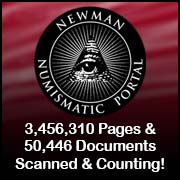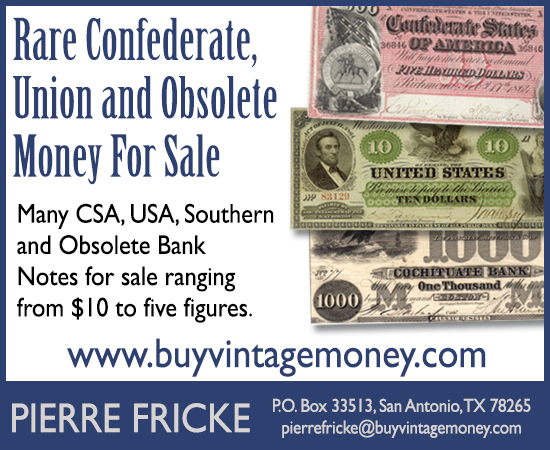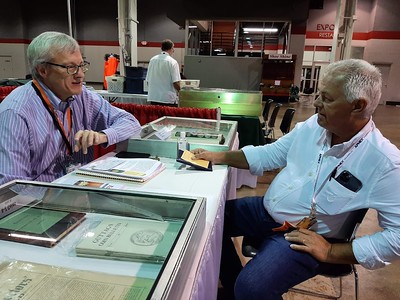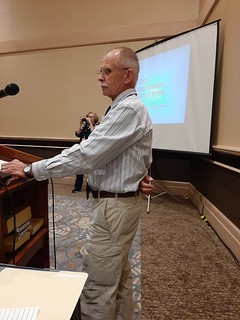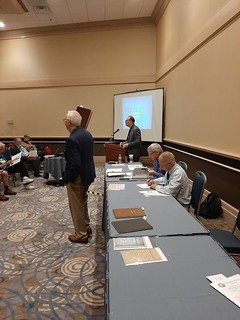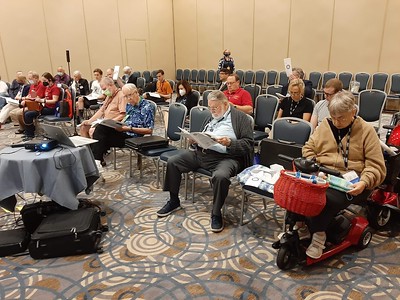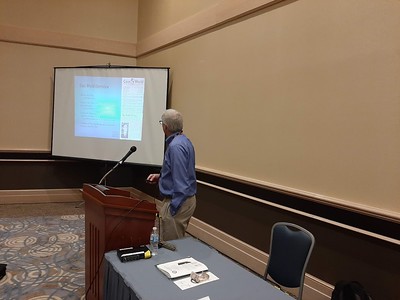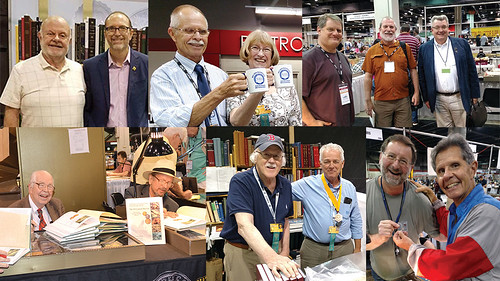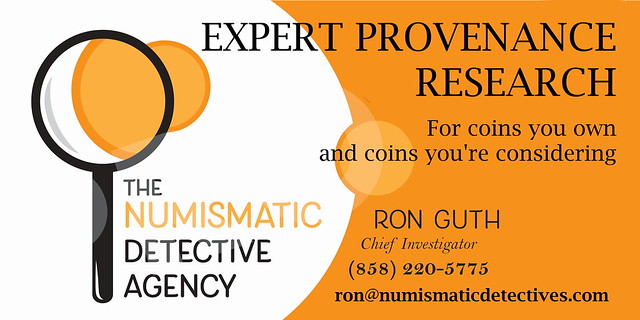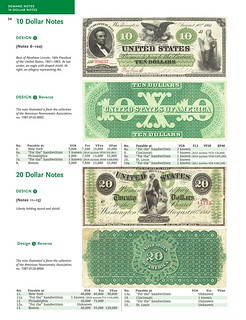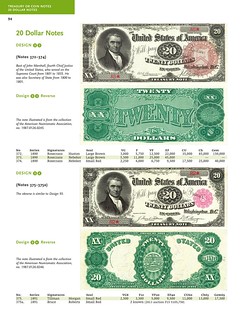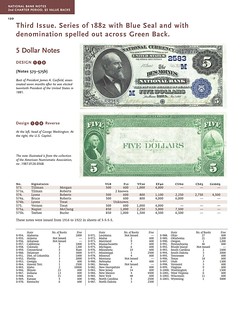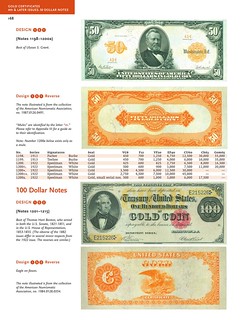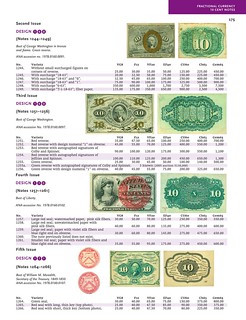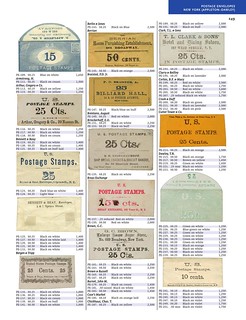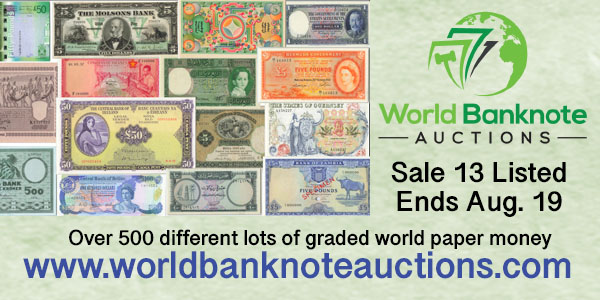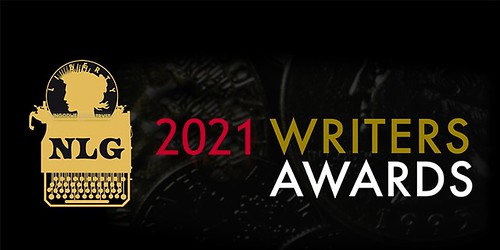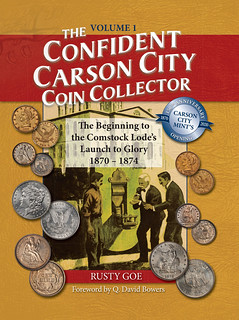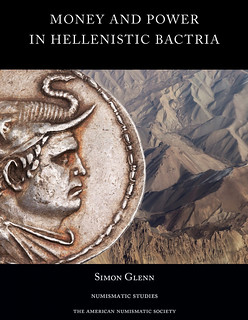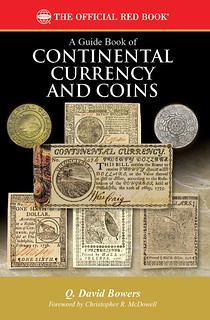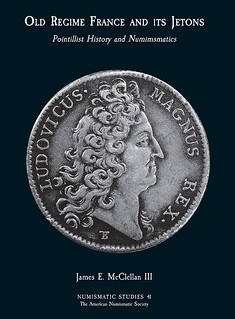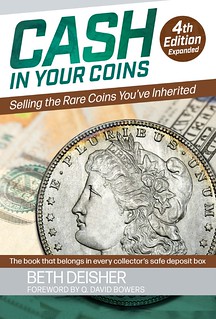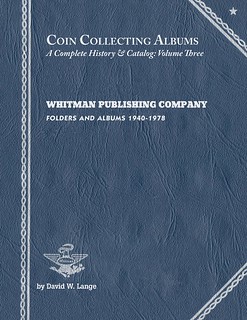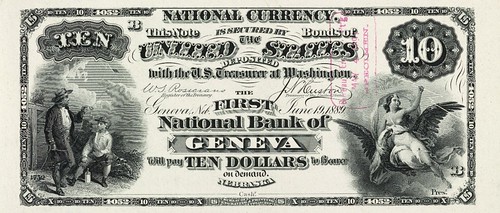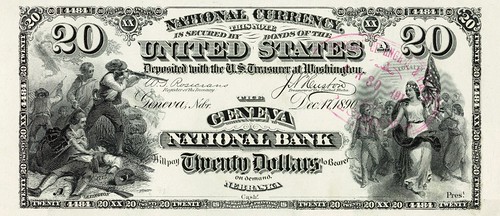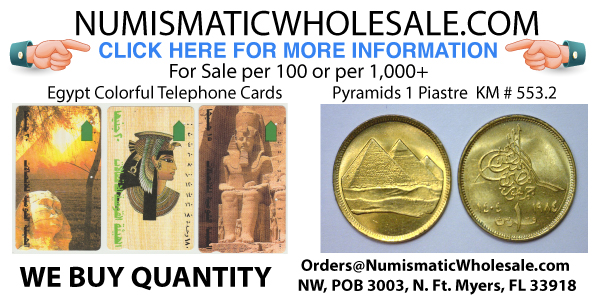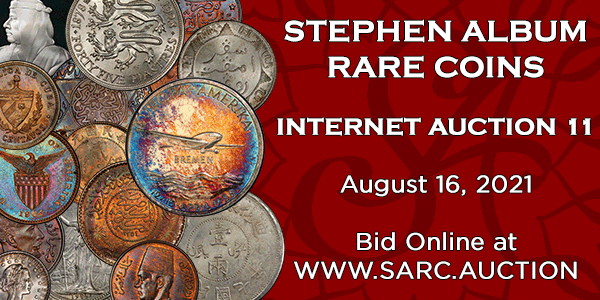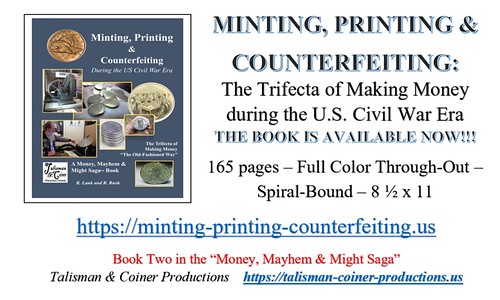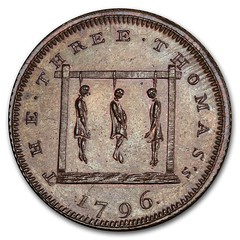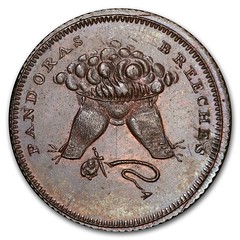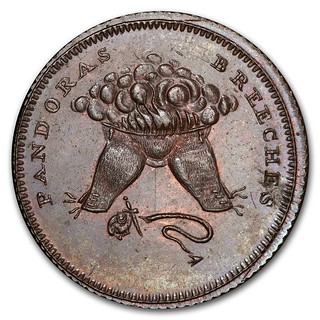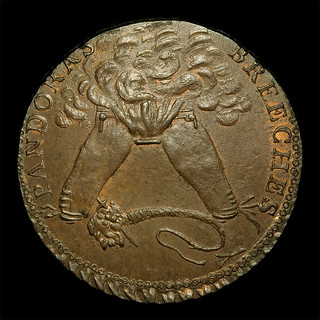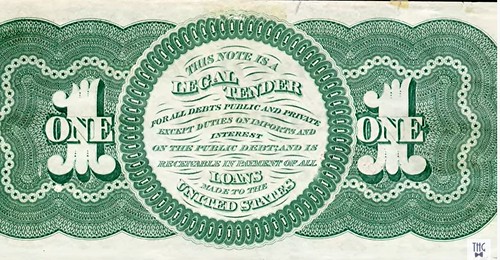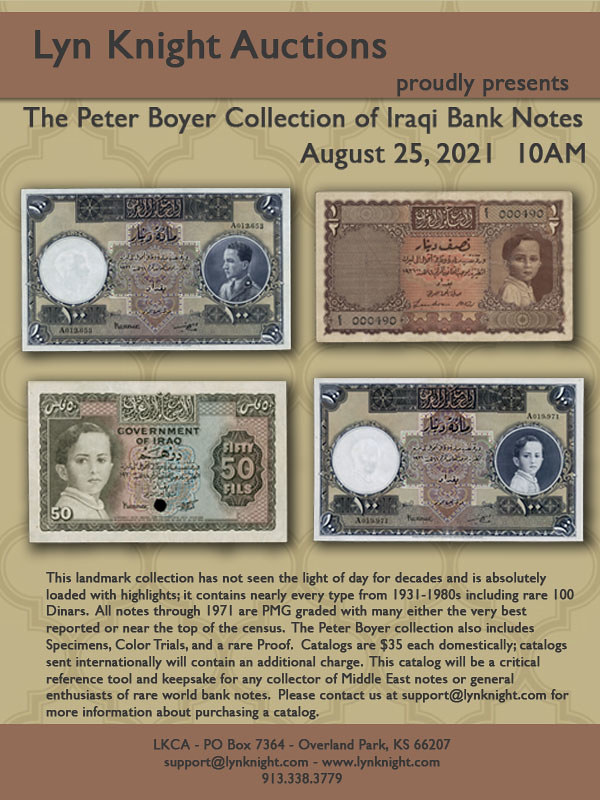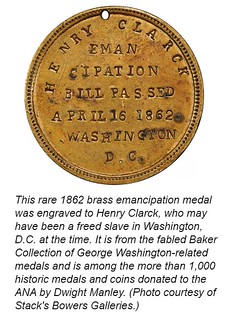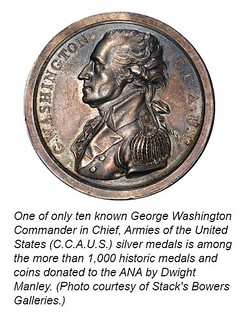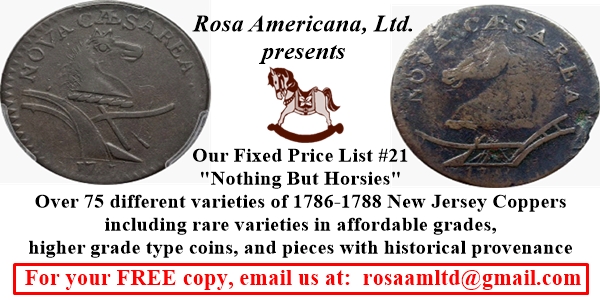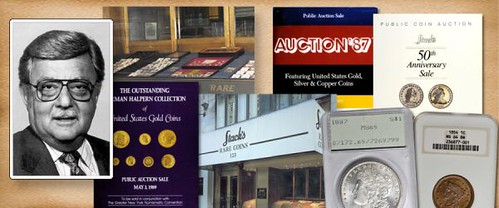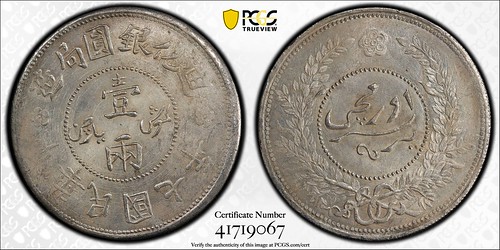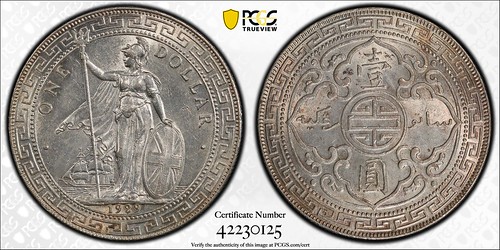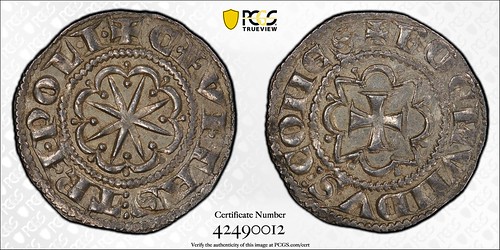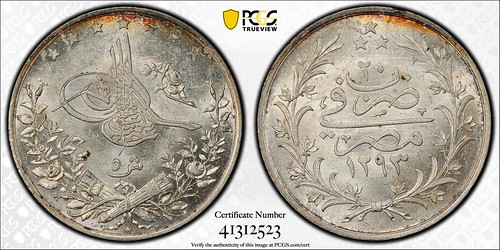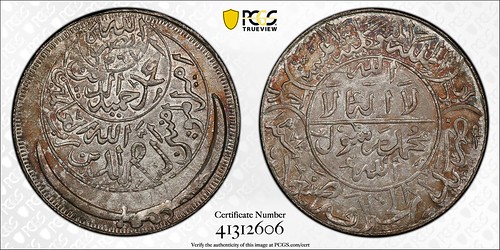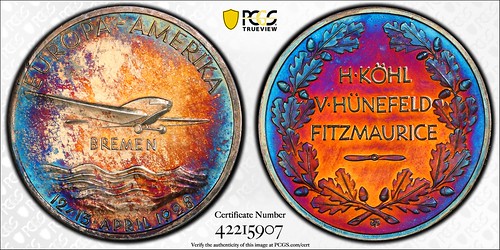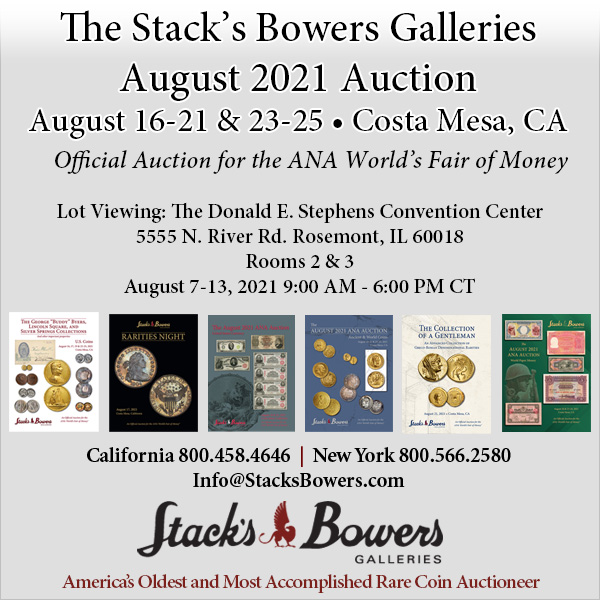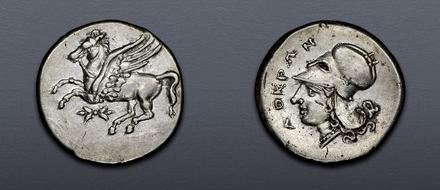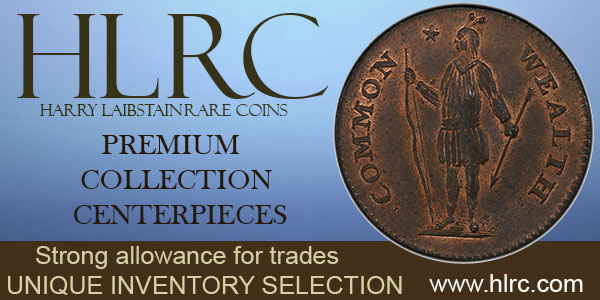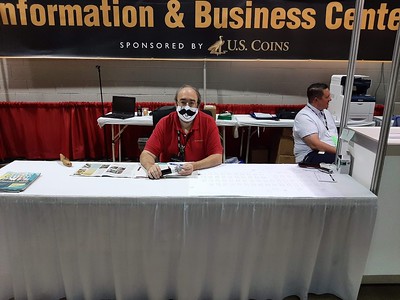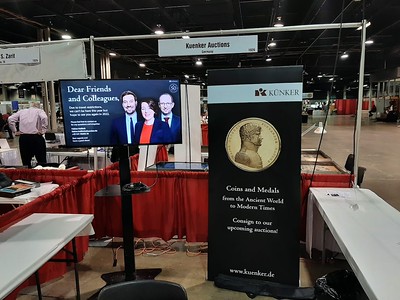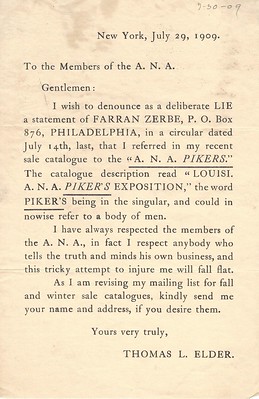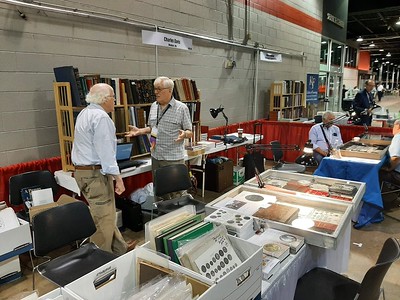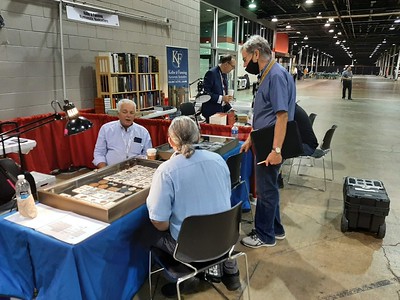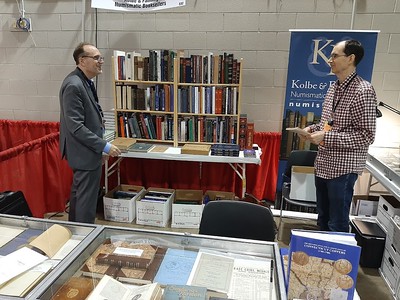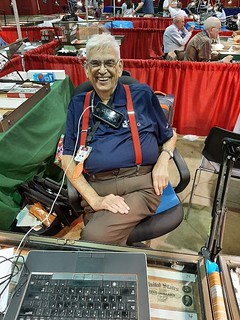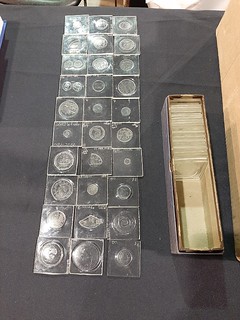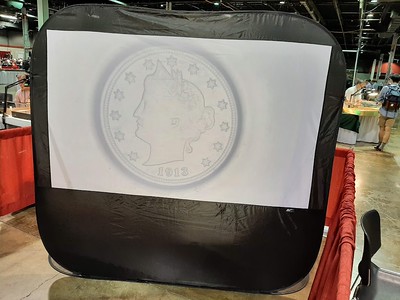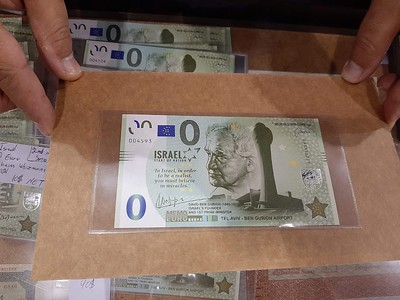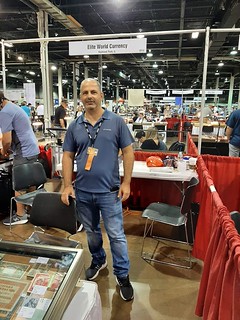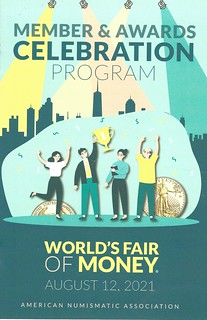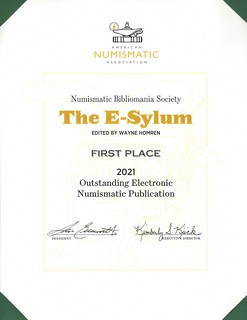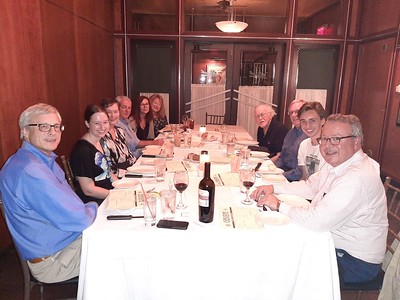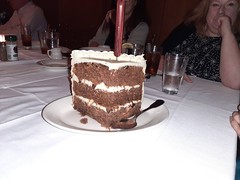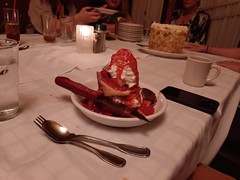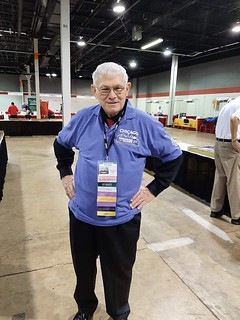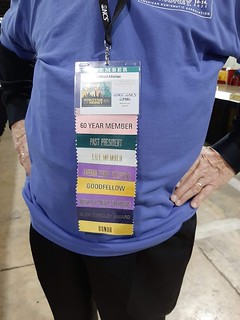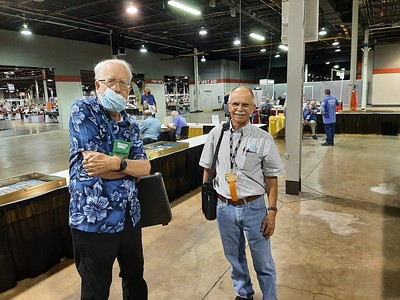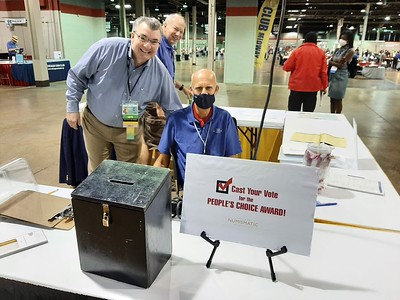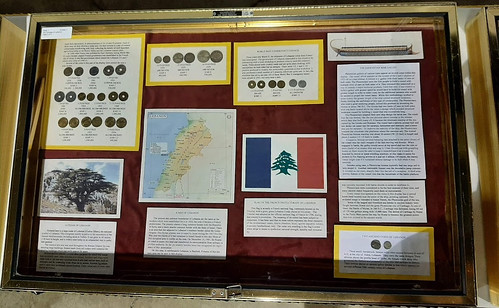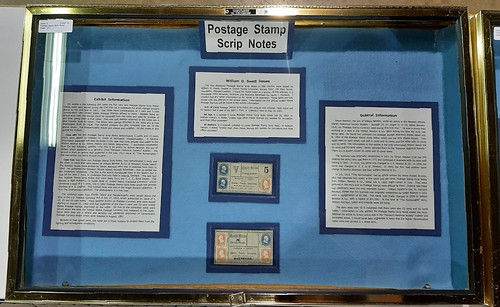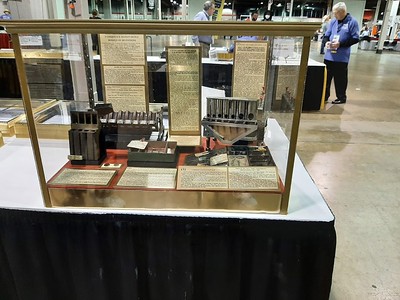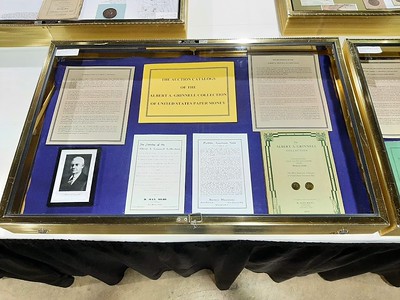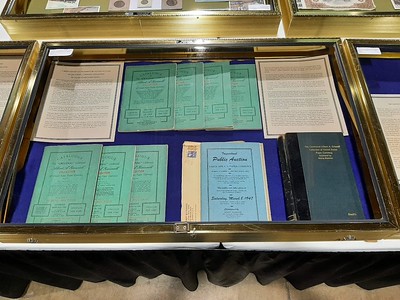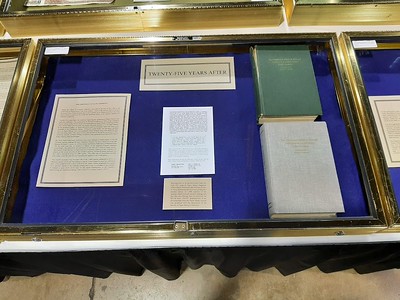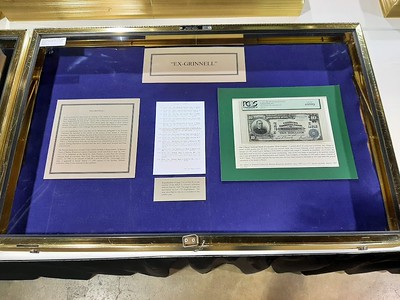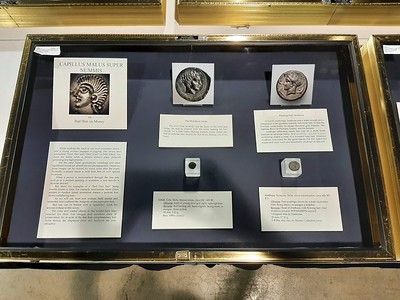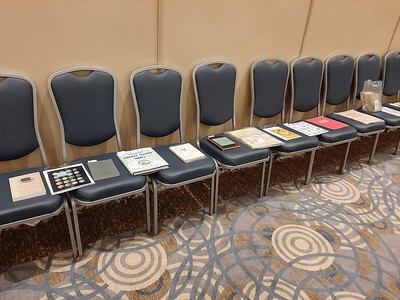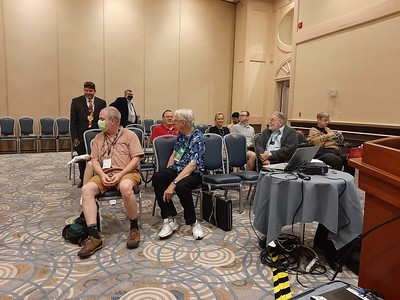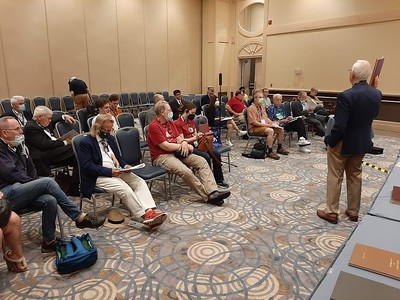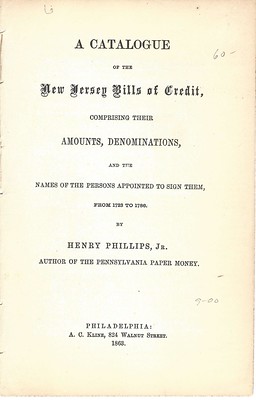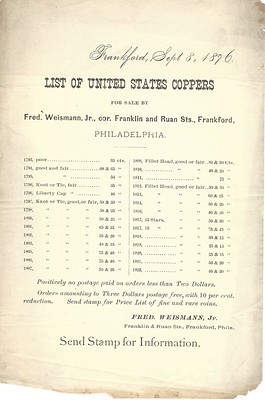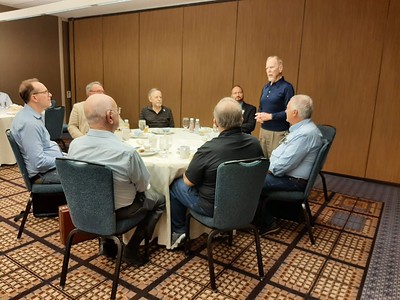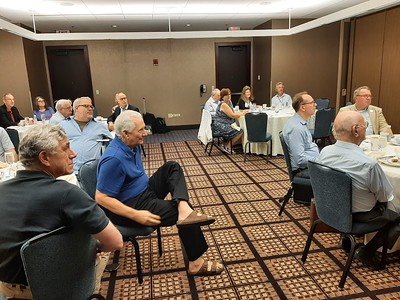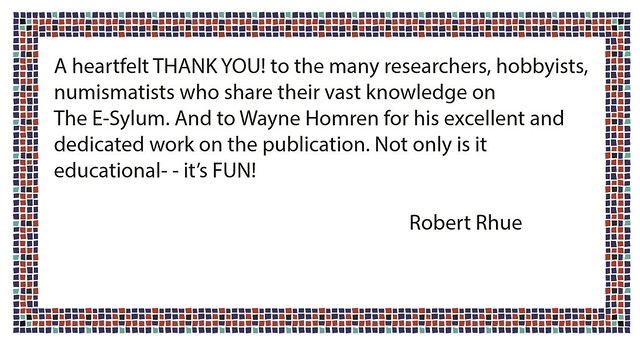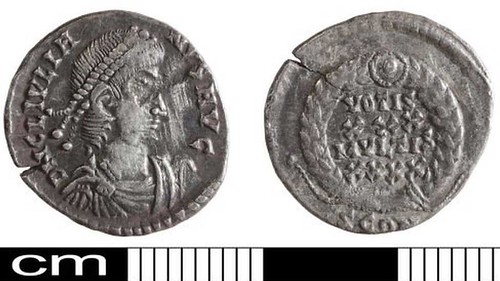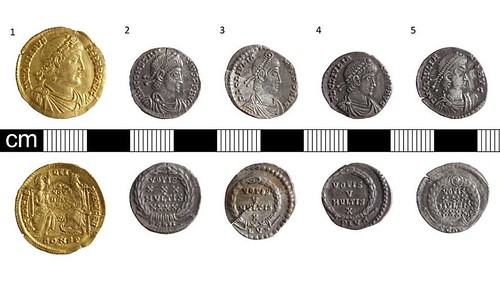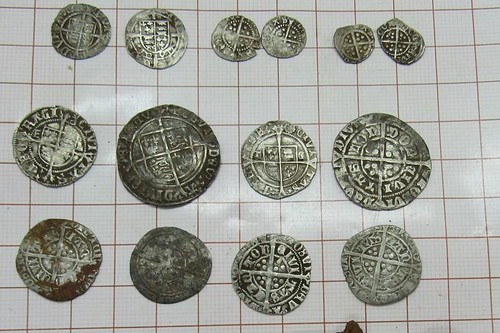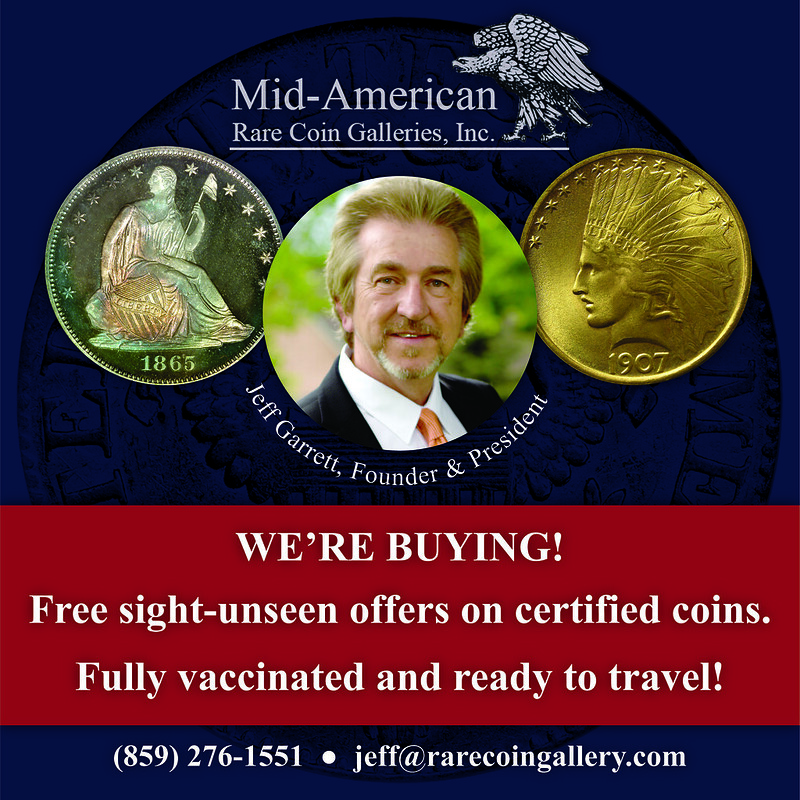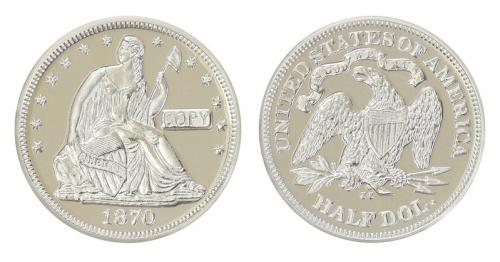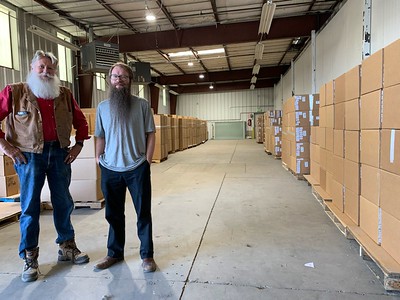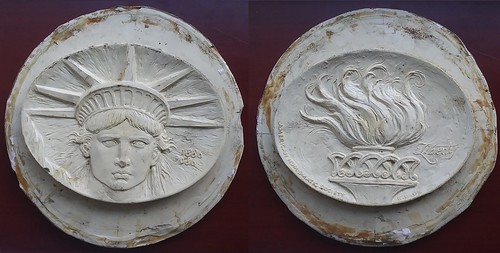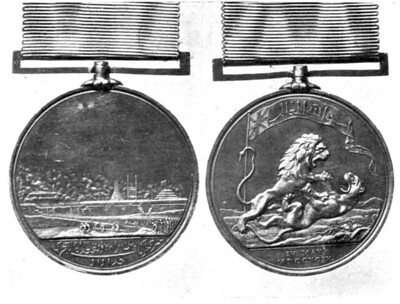
Visit our NBS Sponsors


About UsThe Numismatic Bibliomania Society is a non-profit association devoted to the study and enjoyment of numismatic literature. For more information please see our web site at coinbooks.org SubscriptionsThose wishing to become new E-Sylum subscribers (or wishing to Unsubscribe) can go to the following web page link MembershipThere is a membership application available on the web site Membership Application To join, print the application and return it with your check to the address printed on the application. Print/Digital membership is $40 to addresses in the U.S., and $60 elsewhere. A digital-only membership is available for $25. For those without web access, write to: Charles Heck, Treasurer AsylumFor Asylum mailing address changes and other membership questions, contact Chuck at this email address: treasurer@coinbooks.org SubmissionsTo submit items for publication in The E-Sylum, write to the Editor at this address: whomren@gmail.com BUY THE BOOK BEFORE THE COINSale CalendarWatch here for updates! |
- WAYNE'S WORDS: THE E-SYLUM AUGUST 15, 2021
- SUMMARY OF NBS EVENTS AT 2021 ANA
- CONTRIBUTE TO THE ASYLUM!
- STOCKLEY BOOKS OFFERS U.S. TOP 200 SELECTIONS
- NEW BOOK: CHERRYPICKERS’ GUIDE, SIXTH ED., VOL. 2
- NEW BOOK: PAPER MONEY OF THE U.S., 22ND EDITION
- NEW BOOK: ANTHROPOLOGIE DE LA MONNAIE
- 2021 NUMISMATIC LITERARY GUILD AWARDS
- GEROME WALTON (1934-2021)
- NNP ADDS WALTER BREEN ARCHIVAL MATERIAL
- VIDEO: LIBERTY DOLLAR REBORN
- QUERY: PANDORA'S BREECHES
- NOTES FROM E-SYLUM READERS: AUGUST 15, 2021
- GEORGE WASHINGTON MEDALS DONATED TO ANA
- VOCABULARY TERM: FIELD
- LOUIS ELIASBERG, SR. AND JR.
- HARVEY STACK'S NUMISMATIC FAMILY, PART 102
- STEPHEN ALBUM AUGUST 2021 E-AUCTION 11
- BARTLETT COLLECTION AUCTION TO BENEFIT ANS
- WAYNE'S AUGUST 2021 ANA DIARY
- WAYNE'S AUGUST 2021 ANA DIARY: EXHIBITS
- WAYNE'S AUGUST 2021 ANA DIARY: NBS MEETING
- WAYNE'S AUGUST 2021 ANA DIARY: RITTENHOUSE
- NORFOLK HOARD COIN: DEFACED OR JUST DAMAGED?
- TALMUDIC ERA COIN FOUND IN GALILEE
- GLOUCESTERSHIRE MEDIEVAL COIN HOARD
- 1870-CC LIBERTY SEATED HALF REPLICAS STRUCK
- MOVING MEDALLIC ART COMPANY ARCHIVES, PART 2
- FEATURED WEB SITE: WAR MEDALS
Click here to read the thin version on the web
Click here to subscribe
Click here to access the complete archive
To comment or submit articles, reply to whomren@gmail.com
Content presented in The E-Sylum is not necessarily researched or independently fact-checked, and views expressed do not necessarily represent those of the Numismatic Bibliomania Society.
WAYNE'S WORDS: THE E-SYLUM AUGUST 15, 2021
 New subscribers this week include:
Stan Varnon, courtesy Larry Dziubek;
William Brenner, and
Jeff Koyen.
Welcome aboard! We now have 6,677 subscribers.
New subscribers this week include:
Stan Varnon, courtesy Larry Dziubek;
William Brenner, and
Jeff Koyen.
Welcome aboard! We now have 6,677 subscribers.
Thank you for reading The E-Sylum. If you enjoy it, please send me the email addresses of friends you think may enjoy it as well and I'll send them a subscription. Contact me at whomren@gmail.com anytime regarding your subscription, or questions, comments or suggestions about our content.
As noted last week, we're running late because of my travel to the ANA convention. But here we are! This week we open with a summary of NBS events at the ANA show, a call for contributions to The Asylum, offerings from Richard Stockley Books, three new numismatic books, the NLG awards, updates from the Newman Numismatic Portal, and more.
Other topics this week include Dwight Manley, Gerome Walton, Walter Breen, Bernard von NotHaus and the Liberty Dollar, the Eliasbergs, auction highlights, my ANA show diaries, coin finds, and the Medallic Art Company archives.
To learn more about The BiblioFiles, the Cherrypickers' Guide, U.S. Paper Money, Nebraska National Bank Notes, Pandora's Burning Breeches, the Festival of Coins, Hetty Green's Greenbacks, the Bartlett Collection, William Guild's Plexiglas coin slides, and 1870-CC Half Dollar replicas, read on. Have a great week, everyone!
Wayne Homren
Editor, The E-Sylum
SUMMARY OF NBS EVENTS AT 2021 ANA
Numismatic Bibliomania Society President Tom Harrison submitted this short summary of events at last week's ANA show. -Editor
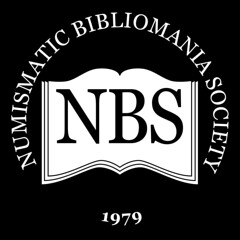 Although we missed many of our friends at this year's NBS events at the ANA World’s Fair of Money, those who were able to attend brought along plenty of enthusiasm for numismatic literature. At the NBS Symposium, Carson City Mint authority Rusty Goe, delivered an entertaining and informative presentation about the Mint on Carson Street.
Although we missed many of our friends at this year's NBS events at the ANA World’s Fair of Money, those who were able to attend brought along plenty of enthusiasm for numismatic literature. At the NBS Symposium, Carson City Mint authority Rusty Goe, delivered an entertaining and informative presentation about the Mint on Carson Street.
The general meeting was highlighted by the presentation of The Asylum awards, a talk by NBS Vice President, Len Augsburger, and the annual charity auction. Lawrence Lee received the Jack Collins Award for his fine article John, the Deaf Guy. The Joel J. Orosz Award was presented to Len Augsburger and Joel Orosz for their outstanding article titled The Rare First Printing of The Fantastic 1804 Dollar: An Explanatory and Comprehensive Census of Surviving Copies. Len’s talk provided a fascinating look at the digitalization of Coin World and Numismatic News.
Thanks to the many generous donors and enthusiastic bidders, the auction realized just over $9,000. Again this year the club table provided a place for aficionados to gather as well as encourage folks to join the NBS. Thanks to everyone who contributed to a great week of biblio fun and fellowship!
Here are a few photos I took at the events. If any of our readers have additional photos or stories to share, please pass them along. -Editor
To learn more about the Numismatic Bibliomania Society, see:
https://www.coinbooks.org/
THE BOOK BAZARRE
CONTRIBUTE TO THE ASYLUM!
While The E-Sylum is free to all, only members of the Numismatic Bibliomania Society receive our award-winning print journal The Asylum. Editor Maria Fanning put out these calls for input from members. The first request (for ANA convention tidbits) has a short deadline; the second (for short personal summaries) is open-ended. Please consider contributing something - we'd love to hear from you.
Not a member yet? See:
https://www.coinbooks.org/about/membership.html
-Editor
Send your photos and stories from this year's ANA to editor Maria Fanning at asylum@coinbooks.org by August 24 for inclusion in the next issue of The Asylum.
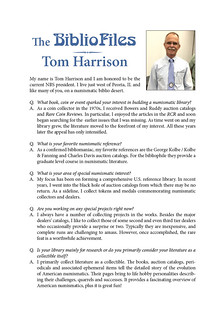 BiblioFiles is a new ongoing feature in The Asylum designed to help NBS members get to know each other better in an increasingly digital world. The purpose is to highlight an NBS member by asking a few brief but fun questions.
BiblioFiles is a new ongoing feature in The Asylum designed to help NBS members get to know each other better in an increasingly digital world. The purpose is to highlight an NBS member by asking a few brief but fun questions.
To the right is a sample by NBS President Tom Harrison to give you an idea of what we’re looking for. Be as creative with your answers as you would like! Please keep the total to a maximum of 350 words, including the questions, since we want to keep the feature to one page. Please email your questions and answers to The Asylum editor Maria Fanning at asylum@coinbooks.org with a portrait photo for inclusion in an upcoming issue.
Here are some sample questions to choose from. I would suggest choosing 3–5 questions, depending on the length of your answers. If you think of another question not on the list that you would prefer to answer, feel free.
- What is your name (and nicknames)?
- Where do you live (ie. town, state, country, in a palace, on a farm, by a lake, with three cats)?
- Where are you most likely to be found (ie. in your library, a bookshop, hiking in a park)?
- What is your area of special numismatic interest?
- What is your favorite numismatic reference (ie. book, periodical, catalogue, website)?
- What is an area outside of your specialty that you would like to know more about?
- Are you working on any special projects right now (please summarize briefly)?
- If you could meet someone from numismatic history, who would it be?
- If you could visit anywhere at any time, where and when would it be?
- What book, coin or event sparked your interest in building a numismatic library?
- Is your library mainly for research or do you primarily consider your literature as a collectible itself?
- If there is one thing you would like other numismatic bibliomaniacs to know about you, what would it be?
We can't wait to get to know you!
STOCKLEY BOOKS OFFERS U.S. TOP 200 SELECTIONS
Building a library of American numismatics? A great place to start is with the top 200 items assembled by the Numismatic Bibliomania Society for the voting for the "100 Greatest" list. Howard R. Engel has a good number of them in stock. -Editor
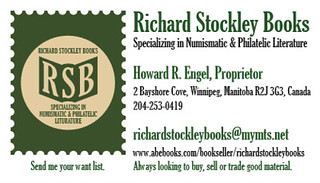 Howard R. Engel of Richard Stockley Books currently has more than 50 of the top 200 nominations for the "100 Greatest Items of United States Numismatic Literature" in his stock (as listed in The Asylum, vol. 27 no. 2, consecutive issue no. 104, Apr.-June 2009, p. 66-75). Send your wants from this list (whether one or 100, plus!) to Howard at
richardstockleybooks@mymts.net as there is at least a 25% chance he could provide you with what you're looking for. If not this time, Howard will keep his eyes open and he'll let you know once your item(s) become available.
Howard R. Engel of Richard Stockley Books currently has more than 50 of the top 200 nominations for the "100 Greatest Items of United States Numismatic Literature" in his stock (as listed in The Asylum, vol. 27 no. 2, consecutive issue no. 104, Apr.-June 2009, p. 66-75). Send your wants from this list (whether one or 100, plus!) to Howard at
richardstockleybooks@mymts.net as there is at least a 25% chance he could provide you with what you're looking for. If not this time, Howard will keep his eyes open and he'll let you know once your item(s) become available.
To read the final "100 Greatest" list, see:
http://wiki.coinbooks.org/index.php/The_One_Hundred_Greatest
_Items_Of_United_States_Numismatic_Literature
Here's the full list of the nominated top 200 items:
http://wiki.coinbooks.org/index.php/Voting_Results:_The_One_Hundred_Greatest_
Works#The_Full_Top_200_List_.26_Voting_Totals
NEW BOOK: CHERRYPICKERS’ GUIDE, SIXTH ED., VOL. 2
It's not quite available for sale yet, but this press release describes the upcoming new edition of the Cherrypickers’ Guide from Whitman Publishing. Pictured is coauthor Bill Fivaz. -Editor
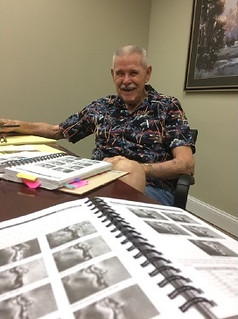 The newest volume of the Cherrypickers’ Guide to Rare Die Varieties of United States Coins has been delayed by the COVID-19 pandemic that shook much of the publishing world as well as society at large. The book’s original coauthor, Bill Fivaz, along with volume editor Larry Briggs and a distinguished panel of contributing specialists, have continued to work on the project, which covers die varieties of U.S. coins from half dimes to gold double eagles, plus commemoratives, bullion, U.S./Philippine coinage, and other series.
The newest volume of the Cherrypickers’ Guide to Rare Die Varieties of United States Coins has been delayed by the COVID-19 pandemic that shook much of the publishing world as well as society at large. The book’s original coauthor, Bill Fivaz, along with volume editor Larry Briggs and a distinguished panel of contributing specialists, have continued to work on the project, which covers die varieties of U.S. coins from half dimes to gold double eagles, plus commemoratives, bullion, U.S./Philippine coinage, and other series.
To cherrypick
in the coin-collecting hobby means to examine a coin that appears normal at first glance, looking for unusual characteristics — like doubled and tripled dies, overdates, and repunched mintmarks — that reveal it to be rare and valuable. In the Cherrypickers’ Guide, close-up photographs and text descriptions instruct the reader in what to look for. The book includes rarity ratings, market analysis, and retail values.
Volume editor Larry Briggs, a professional numismatist well known as an expert in die varieties, is correcting, updating, fine-tuning, adding information, reporting on the market, and generally improving the Cherrypickers’ Guide coverage in a thousand ways,
said Whitman publisher Dennis Tucker, who describes the sixth edition, volume II, as the biggest and best volume of the CPG yet.
The team is wrapping up work, meeting in person and by phone on a regular basis, and conferring with expert dealers, collectors, and researchers.
No hard date has been set for the book’s rollout, but it’s nearing completion and anticipated to be available for the 2021 holiday season.
The sixth edition, volume II, is slated to include more than 800 die varieties, including many new additions. It will cover Capped Bust coinage from half dimes through half dollars; Liberty Seated coinage; Barber silver coins; and every modern series from the early 1900s to date, plus gold dollars through $20 gold coins, classic commemoratives, modern bullion pieces, and coins minted for the Philippines under U.S. sovereignty.
Many coin series are being expanded, and the new book will include some entirely new sections,
said Tucker. This volume includes many of the most popular U.S. coin types, including Mercury and Roosevelt dimes, Washington quarters, Liberty Walking half dollars, Franklin and Kennedy half dollars, Morgan and Peace silver dollars, and modern dollar coins.
Coauthor Bill Fivaz, a coin collector since 1950, has earned recognition as one of the country’s most respected authorities on numismatic errors and die varieties. He is a longtime contributor to the Guide Book of United States Coins (the Red Book
). With the late J.T. Stanton, he coauthored the first Cherrypickers’ Guide in 1990, launching the modern boom in interest in die varieties.
Larry Briggs is well known to the hobby community as a dealer, author, and educator. He served the American Numismatic Association as president of its Authentication Committee. A student of history and archaeology, Briggs served in the U.S. Air Force and worked for Ford Motor Company before launching his own business, Larry Briggs Rare Coins, in 1978. His specialties include error coins and die varieties, Liberty Seated coinage, and early American coppers.
To read the complete article, see:
New Cherrypickers’ Guide, Sixth Edition, Volume II — in the works
(https://mintnewsblog.com/new-cherrypickers-guide-sixth-edition-volume-ii-in-the-works/)
NEW BOOK: PAPER MONEY OF THE U.S., 22ND EDITION
The latest edition of Paper Money of the United States has been announced. Here's the press release. -Editor
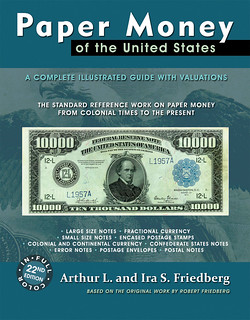 Sixty-eight years after its introduction, the twenty-second edition of Paper Money of the United States, the standard reference book on American currency, is being released by the Coin & Currency Institute at the end of August. In 1953, the late Robert Friedberg (1912-1963) broke new ground when the Treasury Department granted permission for photographs of American paper money to be printed for the first time. The current edition's 328 pages feature notes from America's greatest currency collections, as well as most of the greatest rarities, all reproduced in color.
Sixty-eight years after its introduction, the twenty-second edition of Paper Money of the United States, the standard reference book on American currency, is being released by the Coin & Currency Institute at the end of August. In 1953, the late Robert Friedberg (1912-1963) broke new ground when the Treasury Department granted permission for photographs of American paper money to be printed for the first time. The current edition's 328 pages feature notes from America's greatest currency collections, as well as most of the greatest rarities, all reproduced in color.
The inaugural edition of Paper Money of the United States also introduced other innovations never before attempted. The subject became standardized and the book earned a permanent place on reference shelves. During the past three decades, it has been completely expanded, revised, and edited by Arthur L. Friedberg and Ira S. Friedberg.
The twenty-second edition of Paper Money of the United States, as any price catalog, is a snapshot in time – and as the new edition debuts, it shows that the market for paper money is stable, with notes of great rarity or top quality often setting price records every time they are sold. All valuations have been adjusted to reflect market conditions, which are mostly up. These prices are given in up to seven states of preservation from Very Good (VG8) to Gem Uncirculated (Gem65). In addition to a new, easier to read format, there are also several other significant additions and revisions to the new volume, including notes never before known to exist, making it a necessity for every collector and dealer of American currency.
From the first year of Federal paper money, 1861, to the present, the fronts and backs of all classes and types of currency, from 3 cents to 10,000 dollars are illustrated. These are accompanied by text listing, describing and pricing every variety of paper money ever issued, more than 10,000 prices in all. With close to 1,000 color photographs, the result is a complete pictorial, descriptive and numismatic history of the currency of the United States. There are supplemental sections on Continental and Colonial Currency (notes issued from 1680 to 1788), the Treasury Notes of the War of 1812, considered by some to be the first national currency, a comprehensive listing by type of the issues of the Confederate States of America, and sections devoted to paper money errors, postage envelopes, a new section on postal notes, and encased postage stamps. The latter three, along with Fractional Currency, were created to alleviate the shortage of change needed for commerce during and after the Civil War. The listing in the Appendix of the 14,348 National Banks that existed from 1863 to 1929 also shows the number of notes known to exist for each note-issuing bank. The Appendix also includes information on uncut sheets of small-size notes, including the modern issues sold by the Bureau of Engraving and Printing.
Paper money collectors depend on the Friedberg Numbering System™, a uniform method of cataloging bank notes that is the international standard for American currency. This numbering shorthand, along with the hundreds of photographs, enables anyone to instantly locate a specific banknote, and allows a dealer to advertise a note without need of extensive description. A distinguished panel of acknowledged experts on paper money has assisted the authors, enabling them to establish accurate and up-to-the minute valuations for all issues.
Paper Money of the United States has been an invaluable asset to currency collectors and numismatists for generations. It possesses an appeal and value of its own, not just to lovers of Americana and of the fine art of engraving, but to students of American history, finance and economics. It is recognized as a landmark work and is the undisputed standard reference on American currency – internationally acknowledged as the most comprehensive and universally quoted guide on the subject. Banks in America and throughout the world will find this book especially useful in that it makes possible the immediate identification of all obsolete but still legal tender paper money, while simultaneously giving the collector’s value of each note. It is a book which belongs in every library, public and private.
Sample pages from the 22nd edition may be seen on the book’s website, www.PaperMoneyoftheUS.com.
The book is printed in the United States and is available in three formats. A low-price, easy to carry soft cover version (ISBN 978-087184-522-1) is $45.95. A long-lasting, hard-bound copy with sewn binding (ISBN 978087184-722-5) is $69.95. E-book editions (ISBN 978-087184-022-6) cost $29.95 either on a USB stick (PC only) or as a digital download (multiple formats), where it is also available as a one-day rental. The books are available or may be ordered from book stores, coin and paper money dealers, and from internet book sellers. Copies may also be obtained from the Coin & Currency Institute, P.O. Box 399, Williston, Vermont 05495. Shipping is free in the U.S.A. Major credit cards are accepted. Call toll-free 1-800-421-1866. Fax (802) 536-4787. E-mail: info@PaperMoneyoftheUS.com.
NEW BOOK: ANTHROPOLOGIE DE LA MONNAIE
Hadrien Rambach passed along this information about a new book from France. Thank you. The title roughly translates to English via Google as "For an Anthropology of Money. Reflections on the Teaching of Numismatics in France." -Editor
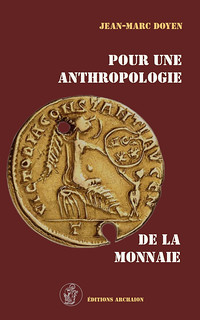 Jean-Marc Doyen, Professeur at Lille University (France), just published a new book entitled Pour une anthropologie de la monnaie. Réflexions sur l’enseignement de la numismatique en France. It is available for only EUR 15 + postage, directly from the author who can be contacted at
librairie.archaion@skynet.be Several other of his books are available too.
Jean-Marc Doyen, Professeur at Lille University (France), just published a new book entitled Pour une anthropologie de la monnaie. Réflexions sur l’enseignement de la numismatique en France. It is available for only EUR 15 + postage, directly from the author who can be contacted at
librairie.archaion@skynet.be Several other of his books are available too.
Jean-Marc DOYEN
Pour une anthropologie de la monnaie. Réflexions sur l’enseignement de la numismatique en France
Bruxelles, Archaion, 2021
19,5 x 25,5 cm, 210 pages, 6 figures dans le texte.
Broché
ISBN 978-2-87214-003-9
Prix : 15 € + port
I've added Google-powered English translations of the additional titles as well. -Editor
Jean-Marc DOYEN
LICINIUS ET CONSTANTIN – Vingt-trois études de numismatique et d’histoire (1978-2019)
LICINIUS AND CONSTANTINE - Twenty-Three Studies in Numismatics and History
Bruxelles, Archaion, 2019
19,5 x 25,5 cm, 182 pages dont 19 planches hors-texte, nombreuses figures en n/b. Broché.
ISBN 978-2-87214-002-2 – Prix : 18,50 € + port
Jean-Marc DOYEN
Prolégomènes à l’économie des Celtes. Innovations technologiques, entrepreneuriat et marchés financiers en Gaule avant César
Prolegomena to the economy of the Celts. Technological innovations, entrepreneurship and financial markets in Gaul before Caesar
Bruxelles, Archaion, 2019
14, 22,5 cm, 189 pages, 32 figures en n/b. Broché.
ISBN 978-2-87214-001-5 – Prix : 17,50 € + port
Jean-Marc DOYEN
L’iconographie numismatique des empereurs Valérien Ier et Gallien. Recueil de travaux originaux (1985-1987),
The numismatic iconography of Emperors Valerian I and Gallienus. Collection of original works
Besançon, 2020
10,5 x 17,5 cm, 314 pages dont 153 pl. hors-texte. Broché.
ISBN 978-2-9562001-6-1 – Prix : 17,50 + port
2021 NUMISMATIC LITERARY GUILD AWARDS
The Numismatic Literary Guild (NLG) is a separate organization from ours, the Numismatic Bibliomania Society (NBS). But we share a love of the numismatic hobby and numismatic research and writing in particular. Congratulations to all of the winners, many of whom are E-Sylum and NBS regulars. Here's the press release for this year's NLG Writers Awards. I've added images of some of the books which were announced or reviewed in earlier E-Sylum issues. See the links below for more information about adding these award-winners to your numismatic library. -Editor
Esteemed researcher and award-winning numismatic author Roger W. Burdette is this year’s recipient of The Clemy, the highest honor given by the Numismatic Literary Guild (www.NLGonline.org).
The Clemy is a coveted, annual award presented in recognition of writing skill, dedication to numismatics, sense of humor and dedication to the Numismatic Literary Guild,
explained former NLG Executive Director Ron Guth.
Founded in 1968, the NLG is a nonprofit organization open to any editors, reporters, authors, writers, catalogers, webmasters, bloggers or producers of audio or video involving all forms of money, medals, tokens and other numismatic collectibles. Information about applying for NLG membership is available online at www.NLGonline.org/membership.
The organization’s annual awards presentation was delivered on August 6, 2021 and can be viewed at https://www.youtube.com/watch?v=yh3xytPDvvE. The video was produced by current NLG Executive Director Charles Morgan.
Here is a list of the 2021 award categories and winner as compiled by NLG awards coordinator David W. Lange.
BEST SPECIALIZED BOOKS
United States or Early American Coins
The Confident Carson City Coin Collector – Rusty Goe
Ancient or Medieval Coins (pre-1500)
Money and Power in Hellenistic Bactria – Simon Glenn
World Coins (1500 to Date)
A Legacy of Collection: The NC Collection of Chinese Coins – Nelson Chang Paper Money
A Guide Book of Continental Currency and Coins – Q. David Bowers
Tokens & Medals
Old Regime France and its Jetons – James E. McClellan III
Numismatic Investment or Marketplace
Cash in Your Coins – Beth Deisher
Numismatic History or Personalities
Coin Collecting Albums, Volume 3, Whitman Publishing Company – David W. Lange
BOOK OF THE YEAR
The Confident Carson City Coin Collector – Rusty Goe
Other top awards went to E-Sylum regulars and supporters Steve Roach, Doug Winter, and Roger Burdette. Congratulations! -Editor
Lee Martin Founder’s Award – Best All-Around Portfolio
Steve Roach
The Ribbit
Douglas Winter
The Clemy
Roger W. Burdette
See the CoinWeek article for the complete list of winners. -Editor
To read the complete article, see:
Numismatic Literary Guild Announces 2021 Award Winners
(https://coinweek.com/coin-clubs/numismatic-literary-guild-announces-2021-award-winners/)
For more information on the Numismatic Literary Guild, see:
https://www.nlgonline.org/
To read the earlier E-Sylum articles, see:
NEW BOOK: CONFIDENT CARSON CITY COIN COLLECTOR
(https://www.coinbooks.org/v24/esylum_v24n05a04.html)
NEW BOOK: MONEY AND POWER IN HELLENISTIC BACTRIA
(https://www.coinbooks.org/v23/esylum_v23n45a04.html)
NEW BOOK: GUIDE BOOK OF CONTINENTAL CURRENCY
(https://www.coinbooks.org/v24/esylum_v24n05a03.html)
NEW BOOK: OLD REGIME FRANCE AND ITS JETONS
(https://www.coinbooks.org/v23/esylum_v23n09a03.html)
NEW BOOK: CASH IN YOUR COINS, 4TH EDITION
(https://www.coinbooks.org/v23/esylum_v23n40a03.html)
NEW BOOK: COIN COLLECTING ALBUMS, VOLUME THREE
(https://www.coinbooks.org/v23/esylum_v23n25a03.html)
GEROME WALTON (1934-2021)
Peter Huntoon submitted this remembrance of paper money collector Gerome Walton; Matt Hansen provided the photo. Thanks! -Editor
Preeminent Nebraska National Collector and Authority
by Peter Huntoon
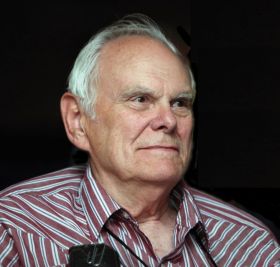 Gerome Walton suffered a severe heart attack on July 22, 2021 and succumbed August 7th in Colorado Springs, Colorado, where he lived. He was 87, having been born June 26, 1934.
Gerome Walton suffered a severe heart attack on July 22, 2021 and succumbed August 7th in Colorado Springs, Colorado, where he lived. He was 87, having been born June 26, 1934.
Walton devoted his free time to amassing the most comprehensive collection of Nebraska national bank notes ever assembled. His publication in 1978 of History of Nebraska Banking and Paper Money was a pioneering release of an encyclopedic book on the national bank note issues from a particular state. The book was 647-pages.
He tirelessly researched obsolete Nebraska note-issuing banks as well as Nebraska national banks, with a focus on the personalities that ran those banks and signed the notes. His work fitted those stories into the large tapestry of the growth of not only Nebraska but also the nation’s banking enterprise.
Gerome was born into a modest home in Geneva, Nebraska, a small rural town in southeastern Nebraska some 60 miles west-southwest of the capital Lincoln. His father was a barber and mother worked at a diner there. He had two brothers.
He graduated from Geneva High School in 1952. Although he had to leave to find opportunity, he had deep roots in Geneva and a fierce loyalty to Nebraska that lasted his lifetime.
Gerome was a big fellow, about 6’ 3 with a sharp technical mind. He joined the Air Force in August 1953 and served a four-year stint. Upon his discharge, he earned an associates degree in electronics from Central Tech Institute in Kansas City in 1959.
By 1961 he was working as an electronics technician for Philco, a firm that pioneered in radios, household appliances, early computers, TV, etc. In short order after he arrived, Philco was purchased by Ford Motor Company and became the Philco-Ford division. Gerome’s job required frequent moves but his attachment to Nebraska never wavered.
He married Ruth McConnell in 1960 and they parented three children, Valerie (1961), Vincent (1963) and Vicky (1970). Ruth was very supportive of Gerome’s numismatic pursuits. She died in January 2011.
In 1962, the Philco 2000 Model 212 computer was selected for use in the North American Aerospace Defense Command's (NORAD) famous Cheyenne Mountain Complex. NORAD is a joint U. S.-Canadian defense organization charged primarily with providing aerospace warnings of threats such as the launch of nuclear missiles by enemies. It operates satellites, ground-based radar, airborne radar and fighters to detect, intercept and, if necessary, engage any threats to Canada and the United States.
NORAD operates a nerve center from a tunnel complex in Cheyenne Mountain, a facility designed to withstand nuclear detonations.
Gerome was transferred to Cheyenne Mountain by Philco-Ford in 1972 to maintain vital electronic equipment there under a civilian contract. Philco-Ford became Ford Aerospace Communications, which eventually was assimilated into defense contractor Lockheed Martin. He retired after spending 32 years as he said going up to the mountain and having the mountain swallow him up.
He held top-secret clearance and didn’t divulge anything of his work to anyone.
Being a resident of Colorado Springs, Gerome naturally volunteered at the American Numismatic, even serving a stint as treasurer.
Gerome’s book on Nebraska notes was pivotal. It accomplished two firsts for the hobby.
He was the first person to crack into the national bank note proofs in the National Numismatic Collection in the Smithsonian Institution. The transfer of the proofs began from the Bureau of Engraving and Printing in 1966 and was completed in 1980. Gerome got wind that the nationals had already arrived as he was gearing up to work on his book. Vladimir Clain-Stefanelli was the curator at the time but was very tightlipped about the proofs because they were in a poor state of organization and poorly housed, and besides he had little interest in them.
After a couple of years of very persistent inquiries, Clain-Stefanelli finally relented realizing this fellow was a serious researcher. He assigned his assistant Butch Vosloh to locate and dig out the proofs for otherwise unreported banks that Gerome wanted to use as illustrations and arranged for them to be photographed. When they appeared in the book, our community indeed saw that this was a treasure trove that had to be mined. Clain-Stefanelli died and Vosloh left for a curatorial job at the BEP. Jim Hughes took over as collections manager and suddenly the doors were thrown open. Now through the Smithsonian website everyone has access to images of the proofs, one of the greatest resources in numismatics.
The other great contribution associated with Gerome's book was his compilation of yearly bank-by-bank president and cashier officer data from the annual reports of the Comptroller of the Currency. In the process, Gerome identified two distinct dates associated with the founding of a national bank, the date of organization and date of charter. He came to realize that the date of organization was the day when the corporate life of a bank began. The date of charter was simply the day the Comptroller authorized the bank to begin business. Until then, virtually no numismatist even knew about the date of organization.
Several of us wondered what the significance of the plate dates were that appear on the faces of large size nationals. Gerome soon recognized that the date of charter or date of organization appeared on the first plates made for all banks from 1882 forward, depending on the vintage of the notes. He also recognized that the dates on the successive series issued by a bank were dates of extension of corporate life.
It was breakthrough news when these insights hit. Using this information as the key, it didn’t take long for us to determine the significance of all the plate dates that appeared on our notes.
A later fundamental contribution that he made came in 2002 when he published an article in Paper Money entitled Impact of Nebraska’s bank deposit guaranty law of 1909-30. This piece developed the story of Nebraska’s bank deposit guarantee law and its impact on national banks in Nebraska. State-run deposit guaranty laws were passed elsewhere in the Plains States, best typified in Oklahoma.
They set up insurance fund to protect depositors in state banks in the event the bank failed. There ensued a rush to liquidate national banks and reorganize them under state charters to take advantage of this program. It didn’t take long for the state insurance funds to face bankruptcy and the idea imploded. Many banks that had fled the national system quickly returned, usually with their identical former names.
Gerome joined with me and for a time with Mark Hotz to offer a national bank note course through the ANA summer seminar series. We didn’t miss many summers between 2000 and the Covid crash in 2020. The highlight for participants was when Gerome arrived lugging his collection that spilled out and overflowed all the tables in the room as he spun his tales. He indeed set the standard for how to enjoy this stuff and it continued to thrill him to the end.
Gerome wrote several articles, most for The Numismatist, chronicling the interesting and ironic tales associated with Nebraska note-issuing banks and bankers. He always was plugging away at another Nebraska story, and did so right up until he died in the saddle. There is unfinished work spread around his living room.
Gerome was a rather laid-back unassuming guy. Underneath that veneer was a tireless methodical person with stereotypical Germanic drive. He was a fellow from rural Nebraska who revealed in the mystique of having his feet planted firmly in a Plains State and culture. He approached life with an optimism, wry sense of humor and an enduring youthful sense of awe that were infectious. He generously pressed his passion on to anyone willing to engage him. His manner of speech was understated. Excitement elicited Jiminy!
A surprise or reversal was punctuated with Jeepers!
Although he spent most of his career in Colorado Springs, Gerome’s hometown remained Geneva, Nebraska, where he is to be interred with Ruth.
Gerome’s numismatic regret was never finding a note from either of the two national banks that operated in Geneva. They were The First National Bank of Geneva, charter 4052, and The Geneva National Bank, charter 4484. Both were early short-lived banks that issued pocket change in $10 and $20 Series of 1882 brown backs. The First National was chartered in 1889 and liquidated just three and a half years later in 1894. The Geneva National opened in 1891 and was liquidated in 1899 in order to be reorganized as the Geneva State Bank. No notes have been reported from either bank.
NNP ADDS WALTER BREEN ARCHIVAL MATERIAL
The latest addition to the Newman Numismatic Portal is archival material of author/researcher Walter Breen. Project Coordinator Len Augsburger provided the following report. -Editor
Newman Portal Posts Material from Walter Breen Archives
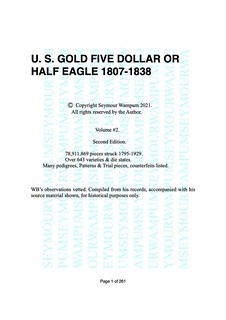 Bruce Vogel acquired portions of the Walter Breen papers in the early 1990s and has graciously shared this material with Newman Portal. Recently added is a 14-volume work on U.S. gold coins, 1795-1933, compiled by Vogel (aka Seymour Wampum) from Breen’s notes and sources. Although superseded by references such as Doug Winter’s series on mintmarked gold varieties, or John Dannreuther’s groundbreaking 2-volume set on proof U.S. gold coins, one still finds useful tidbits within the Breen work.
Bruce Vogel acquired portions of the Walter Breen papers in the early 1990s and has graciously shared this material with Newman Portal. Recently added is a 14-volume work on U.S. gold coins, 1795-1933, compiled by Vogel (aka Seymour Wampum) from Breen’s notes and sources. Although superseded by references such as Doug Winter’s series on mintmarked gold varieties, or John Dannreuther’s groundbreaking 2-volume set on proof U.S. gold coins, one still finds useful tidbits within the Breen work.
Breen includes numerous auction citations as well as references to National Archives material such as the Charlotte Mint Bullion Journal. Much of the material seems to have been left on the cutting room floor when preparing his 1988 Encyclopedia, no doubt for reasons of brevity. Breen’s work here has been compiled by Vogel in scrapbook form, with entries apt to contain typed or handwritten notes, pages excerpted from auction sale catalogs, etc. Researchers or collectors looking for information on specific dates and mintmarks will do well to consult this source, in addition to more modern references such as those noted above.
Link to Breen’s compiled notes on U.S. gold coins:
https://nnp.wustl.edu/library/archivedetail/323?Year=2021&take=50
VIDEO: LIBERTY DOLLAR REBORN
These are selections from the David Lisot Video Library that feature news and personalities from the world of coin collecting. David has been attending coin conventions since 1972 and began videotaping in 1985. The Newman Numismatic Portal now lists all David’s videos on their website at:
https://nnp.wustl.edu/library/multimediadetail/522852
Here's an interview with Liberty Dollar architect Bernard von NotHaus. -Editor
Liberty Dollar Reborn!
Bernard von NotHaus, Monetary Architect,
David Lisot, Interviewer, CoinTelevision.com. July 9, 2021.
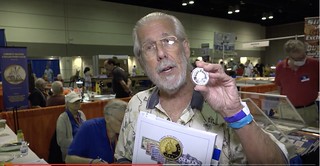 The Liberty Dollar has been a controversial coin ever since it was first introduced. The original issue was in violation of Federal Law Section 486 and caused its creator, Bernard von NotHaus, to be incarcerated. Hear the story of the new Liberty Dollar and the book that explains the history of how and why it was created.
The Liberty Dollar has been a controversial coin ever since it was first introduced. The original issue was in violation of Federal Law Section 486 and caused its creator, Bernard von NotHaus, to be incarcerated. Hear the story of the new Liberty Dollar and the book that explains the history of how and why it was created.
An excerpt of the video is available for viewing on the Coin Television YouTube Channel at:
https://youtu.be/ZpQ9XR1hUWY
QUERY: PANDORA'S BREECHES
Ray Williams writes:
"In last week’s E-Sylum you posted the answer to the three Thomas's portrayed on the Middlesex token. What is the symbolism for the pants on the reverse?"
I didn't know what to make of the reverse. I'd heard of Pandora's box but not Pandora's breeches. But I found this 2011 post over on the Collectors Universe forum. -Editor
Serpent Pandora's Breeches, 1792, designed by Thomas Spence, London. It depicts Priestley as a serpent below a burning pair of straw-filled pants, labeled "Pandora's Breeches."
If the plot to burn down Parliament had succeeded, the token implies that all hell would have broken loose, just as in the myth of Pandora's box.
I found another image over on CoinTalk. -Editor
There's a book with the title "Pandora's Breeches" but the descriptions and reviews I've read (and there seem to be hundreds) don't say where the title comes from. The phrase is probably a contemporary reference, but I've come up empty looking for one. -Editor
To read the complete posts, see:
Its Friday and the weekend is here....post anything you want
(https://forums.collectors.com/discussion/807536/its-friday-and-the-weekend-is-here-post-anything-you-want)
https://www.cointalk.com/threads/lets-see-your-conder-tokens.107719/page-20
To read the earlier E-Sylum article, see:
NOTES FROM E-SYLUM READERS: AUGUST 8, 2021 : The Three Thomas's
(https://www.coinbooks.org/v24/esylum_v24n32a15.html)
NOTES FROM E-SYLUM READERS: AUGUST 15, 2021
Catalog of the World's Most Popular Coins
Martin Purdy writes:
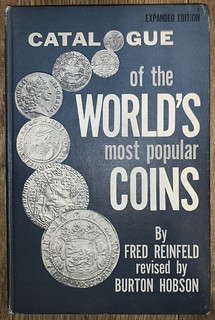 "I was struck by the quite critical tone of the references to Fred Reinfeld and Burton Hobson in last week's E-Sylum. Their Catalog of the World's Most Popular Coins was a volume I read cover to cover as a child, several times over on repeated borrowings from my local library, and some decades later I acquired a copy of my own to dip into in an attempt to recapture some of the fascination the book held for me almost 50 years ago.
"I was struck by the quite critical tone of the references to Fred Reinfeld and Burton Hobson in last week's E-Sylum. Their Catalog of the World's Most Popular Coins was a volume I read cover to cover as a child, several times over on repeated borrowings from my local library, and some decades later I acquired a copy of my own to dip into in an attempt to recapture some of the fascination the book held for me almost 50 years ago.
"On a quick search of my numismatic book list I have five titles published by Sterling, all of which have either Reinfeld or Hobson as one of the authors, though not the one mentioned in your "overdue book" item. I accept they're at the "populist" end of the scale, but is that the only objection, or is there more to it than that?
"Curious!"
I didn't see last week's comments as overly critical - they were simply acknowledging the "populist" nature of many of the titles. I do agree that Catalog of the World's Most Popular Coins was a useful work at the time. -Editor
To read the earlier E-Sylum article, see:
A LONG-OVERDUE NUMISMATIC LIBRARY BOOK
(https://www.coinbooks.org/v24/esylum_v24n32a32.html)
AINA Forum Update
Mel Wacks submitted this update to the upcoming AINA Zoom Forum with Dr. David Jacobson on "Antioch and Jerusalem, the Seleucids and Maccabees in Coins." -Editor
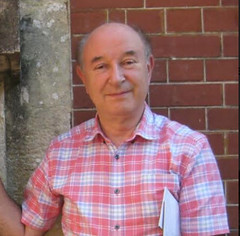 The next AINA (American Israel Numismatic Association) forum will feature Dr. David Jacobson, Associate of the Faculty of Oriental Studies Faculty, University of Oxford, and winner of AINA’s 2021 Shekel Prize Medal. The forum will be held jointly with the Anglo-Israel Archaeological Society. Jacobson’s talk will be about
The next AINA (American Israel Numismatic Association) forum will feature Dr. David Jacobson, Associate of the Faculty of Oriental Studies Faculty, University of Oxford, and winner of AINA’s 2021 Shekel Prize Medal. The forum will be held jointly with the Anglo-Israel Archaeological Society. Jacobson’s talk will be about Antioch and Jerusalem, the Seleucids and Maccabees in Coins,
the subject of his book with the same title. The zoom talk will take place on August 22 at 7 PM in England, corresponding to 2 PM EST, 11 AM PST, and 9 PM in Israel.
Please register in advance at https://us02web.zoom.us/meeting/register/tZIvd- yuqDIpE9NfLI9WhrlTaNDA8YfwVYEJ After registering, you will receive a confirmation email containing information about joining the meeting.
Jacobson’s work recounts the heroic story of the Maccabees and explains how they successfully took on the might of the Seleucid realm, illustrated by the coins issued by the main protagonists. The author writes: What was an epic struggle of an oppressed people to win their national and religious freedom has provided much inspiration through the ages and continues to strike a strong resonance in our own times. However, the historical drama, as recorded in 1 and 2 Maccabees, with its unfamiliar roll-call of major players and place names, has acquired a considerable mystique. The coins put faces to many of these seemingly obscure names and help bring those stirring events back to life.
For more information, see the earlier E-Sylum article:
AINA FORUM: ANTIOCH AND JERUSALEM
(https://www.coinbooks.org/v24/esylum_v24n27a06.html)
Festival of Coins Contributors Sought
Matt Hill of All About Coins writes:
 "We’re excited to be running our second ‘Festival of Coins’ from 17 to 26 September this year at
www.allaboutcoins.co.uk, and I wondered if you or any of your colleagues had any content you would like to put forward. Content ideas could include special articles, videos, coin galleries, exclusive insight into a collection and any special offers for collectors. I look forward to your thoughts on this idea and would very much welcome your involvement."
"We’re excited to be running our second ‘Festival of Coins’ from 17 to 26 September this year at
www.allaboutcoins.co.uk, and I wondered if you or any of your colleagues had any content you would like to put forward. Content ideas could include special articles, videos, coin galleries, exclusive insight into a collection and any special offers for collectors. I look forward to your thoughts on this idea and would very much welcome your involvement."
The Festival of Coins is a nice online event, allowing for participation from both sides of the Atlantic. Consider contributing. -Editor
To sign up for the free the All About Coins newsletter., see:
https://www.allaboutcoins.co.uk/account/register
Hetty Green's Greenbacks
Col. E.H.R. "Ned" Green accumulated one of the greatest coin collections of all time with money inherited from his mother, the richest woman in America - Hetty Green. Chip Howell passed along this recent YouTube video from The History Guy about Hetty Green. There's nothing much numismatic here, but there is an interesting connection; Hetty bought deprecated U.S. greenbacks at 50 cents on the dollar, and made a handsome profit when they were ultimately redeemed at face value. But how much more would they be worth now in the collector market? -Editor
To watch the video, see:
Hetty Green: The Witch of Wall Street
(https://www.youtube.com/watch?v=FHeOOVxGft8)
GEORGE WASHINGTON MEDALS DONATED TO ANA
The big news at the end of the ANA convention this week was Dwight Manley's donation to the ANA Money Museum. Here's the press release. -Editor
of George Washington Medals from Dwight Manley
Benefactor's multi-million dollar exonumia donation includes over 800 medals from Historical Society of Pennsylvania's famous Baker Collection
More than 850 gold, silver and bronze medals related to President George Washington that were deaccessioned by the Historical Society of Pennsylvania have been donated intact to the American Numismatic Association's (money.org) Edward C. Rochette Money Museum by prominent California rare coin dealer and real estate developer Dwight Manley.
Manley's generous donation also includes other important Washington-related medals he separately acquired over the years that were not part of the historical society's collection originally assembled by 19th century numismatist and researcher William Spohn Baker (1824-1897). In all, more than 1,000 medals and coins are in the donation.
To be known as the Baker-Manley Collection, the multi-million dollar donation was announced at the ANA Banquet on August 13, 2021 during the Association's Chicago World's Fair of Money®.
"This collection is the ultimate grouping of numismatic Washingtonia not only for its size but, more importantly, for its provenance – it was formed by William Spohn Baker, the first numismatic researcher to compile a systematic and comprehensive catalog of the vast series of medals related to George Washington," states Doug Mudd, curator and director of the ANA museum.
Hundreds of different medals celebrating George Washington were privately produced in the decades before and after his death in December 1799.
In 1885, Baker authored what is still considered the standard reference book on the subject, "Medallic Portraits of Washington," and donated his famous collection in 1897 to the Historical Society of Pennsylvania. Manley purchased more than 75 percent of the society's Baker Collection of Washingtonian medals when 1,102 of them were offered at auction by Stack's Bowers in November 2019.
"The Baker Collection languished for more than a century in storage at the historical society. When the medals came on the market, I wanted to keep as much of the collection intact as possible," says Manley. "Now these important numismatic treasures will be part of the ANA's holdings and available for public exhibits and future study."
"These are the Mount Rushmore of medals; each one has a story. In addition to exhibits in the Money Museum and at ANA conventions, they could be used for Summer Seminar and Florence Schook School of Numismatics classes, for research to update the Baker reference book or even create a 'Birth of a Nation' book using illustrations of George Washington medals. The collection is a portrait of American history through images of our first president," he states.
Highlights of the donated Baker Collection include:
- A rare 1862 brass Washington, D.C. emancipation medal depicting George Washington (Musante GW-566, Baker-620), PCGS AU58, engraved to Henry Clarck, who may have been a freed slave at the time. President Abraham Lincoln signed the national Emancipation Proclamation in January 1863, but Washington, D.C. enacted emancipation months earlier in April 1862.
- A superb quality example of a silver 1805 medal commemorating the Peace of 1783 (Musante GW-92, Baker-58, Julian CM-5), PCGS SP64, the fourth and final entry in the History of the Revolution Medal series.
- One of only ten known 1805 Commander in Chief, Armies of the United States (C.C.A.U.S.) silver medals (Musante GW-90, Baker-57, Julian CM-6), PCGS SP58, produced as the first of an intended series of medals celebrating the history of the Revolution. Stack's Bowers, the auction house that sold the historical society's Baker Collection, stated: "The C.C.A.U.S. medal has long been considered a landmark of the Washington series."
Among the important medals separately acquired by Manley and now donated to the ANA are:
- A spectacular, silver 1792-dated oval Indian Peace medal with an engraving depicting Washington extending his hand in friendship and peace to a pipe-smoking native American who has placed his long-handled battle axe on the ground as a gesture of goodwill. It is one of only five known of this date.
- An 1800 gold funeral medal produced by diemaker Jacob Perkins (1766-1849) of Newburyport, Massachusetts that was worn at a February 1800 funeral procession in Boston held in honor of Washington about two months after he died at his Mount Vernon home in Virginia.
"We are beyond thankful to Dwight Manley for bestowing this incredible gift of history and art to the Association," says ANA Executive Director Kim Kiick. "We look forward to sharing pieces from this wonderful collection in the upcoming Money Museum exhibit in March of 2022."
Manley has been a benefactor to the ANA for many years. In 2003, the Association named its library in his honor.
As Managing Partner of the California Gold Marketing Group, he is well-known in the numismatic community for his work with recovered sunken treasure from the fabled "Ship of Gold," the SS Central America that sank in 1857 while carrying tons of California Gold Rush-era coins and assayers' ingots. He also is Managing Partner of real estate development company Manley Fanticola Partners in his hometown of Brea, California.
To read the earlier E-Sylum articles, see:
THE COLLECTION OF WILLIAM SPOHN BAKER
(https://www.coinbooks.org/v22/esylum_v22n45a19.html)
THE SELLING OF THE BAKER COLLECTION
(https://www.coinbooks.org/v23/esylum_v23n08a30.html)
DWIGHT MANLEY ACQUIRES BULK OF BAKER COLLECTION
(https://www.coinbooks.org/v23/esylum_v23n09a28.html)
WILLIAM SPOHN BAKER (1824-1897)
(https://www.coinbooks.org/v23/esylum_v23n50a16.html)
VOCABULARY TERM: FIELD
Here's another entry from Dick Johnson's Encyclopedia of Coin and Medal Terminology. -Editor
Field. The background of a numismatic item not occupied by device, symbols or lettering. The field is generally smooth – collectors call this clean field – particularly for coins. All relief design projects from this surface. The term field differs little in meaning from background; background may have additional design in it (called background texture), while the field has no design as such. Thus background differs from field in that it can be smooth or have texture.
Since the field recedes from the viewer, it is the lowest part of the struck surface; thus it is the highest part of the die. As such, it is the first area susceptible to rust spots and damage from objects dropped on an unprotected die. The field is the easiest to proof polish to become the proof surface. The field is also known as the ground in repoussé and embossing work; the matrix in sculpture, and the table in diemaking. All these terms mean virtually the same surface, they are used by different professions at different steps in the creation and life of a coin or medal. See chart.
| Term | Who Uses Term |
|---|---|
| background | Artists, Designers |
| field | Numismatists |
| clean field | Collectors |
| ground | Embossers |
| matrix | Sculptors |
| table | Diemakers |
To read the complete entry on the Newman Numismatic Portal, see:
Field
(https://nnp.wustl.edu/library/dictionarydetail/515897)
THE BOOK BAZARRE
LOUIS ELIASBERG, SR. AND JR.
Here's a new article submitted by American Numismatic Biographies author Pete Smith. Thanks! -Editor
Last week we asked the question, What person named Eliasberg is in the Hall of Fame in Colorado Springs? Some readers may have thought the answer was Louis Eliasberg, Sr. This is incorrect. Here is the bio for him from American Numismatic Biographies.
Eliasberg, Louis Edward Sr. Collector (b. 2/12/1896 d. 2/20/1976)
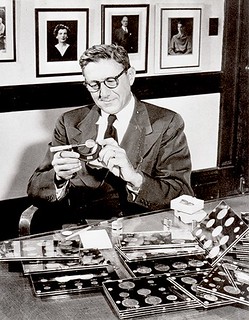 Born in Selma, Alabama, the son of Adolph Eliasberg and Hortense Rosalinde Schwartz. He attended Baltimore City College 1912-14. Graduate of the Wharton School of the University of Pennsylvania.
Born in Selma, Alabama, the son of Adolph Eliasberg and Hortense Rosalinde Schwartz. He attended Baltimore City College 1912-14. Graduate of the Wharton School of the University of Pennsylvania.
Married Hortense Miller Kahn June 1, 1927. She died in December 1949. Married R. Lucille Jones. He had two sons, Louis Eliasberg, Jr. and Richard. President of the Finance Company of America. He died at home in Baltimore and is buried at Baltimore Hebrew Cemetery.
Eliasberg attempted to collect an example of every coin listed in Green's Mint Record and Type Table. He purchased via Stacks the John Clapp collection in 1942 for more than $100,000. This was described as the largest single cash transaction in numismatic history. The last coin he needed was the 1873-CC no arrows Liberty Seated dime, acquired in 1950. He acquired a 1933 $20 Double Eagle but voluntarily surrendered it to the government.
In 1947 duplicates from the Eliasberg collection were sold by Stacks as the H. R. Lee collection. His mother’s initials were H.R. and his initials were L.E.E. His story and collection were featured in an April 27, 1963, issue of Life magazine. Another article was in LOOK magazine on December 29, 1964. He served on the Assay Commission for 1962. The Eliasberg collection was exhibited at the Philadelphia Mint in 1976. It was exhibited extensively around the country in cities such as Chicago, Dallas, Philadelphia and New York.
Eliasberg consigned coins to a Stack's auction in 1947 and a New Netherlands auction in 1957. On October 27-29, 1982, Bowers & Ruddy Galleries auctioned The United States Gold Coin Collection. Although it was not identified as the Eliasberg collection, the history of the collection was well known.
Louis Eliasberg, Sr. is not in the American Numismatic Association Hall of Fame. As the only person to form a complete collection of United States coins. Perhaps he should be.
The correct answer this week is his son, Louis Eliasberg, Jr.
Louis Eliasberg, Jr. (1929-2009) developed timing systems for speed skating and timed national and North American events for 18 years. During that period he also filmed the events. He was inducted into the National Speedskating Hall of Fame in Colorado Springs on May 19, 1990.
For next week, Pete asks:
"What living numismatist makes his living as a paper hanger?"
To read the earlier E-Sylum article, see:
HOWARD GIBBS AND JOHNNY UNITAS
(https://www.coinbooks.org/v24/esylum_v24n32a20.html)
HARVEY STACK'S NUMISMATIC FAMILY, PART 102
The latest article in Harvey Stack's blog series covers the year 1987 and the early days of third-party grading services. -Editor
The year 1987 witnessed a mass expansion of the use of third-party grading services in the numismatic hobby, both by dealers and collectors. The issue of standardizing grading was not new as it had been an ongoing situation that could be traced back for decades, even centuries. Over the course of time there had been various attempts to define and perfect the art of grading, as have been discussed in earlier parts of this story. These included Dr. William Sheldon's numerical grading system that he first published in Early American Cents in 1949, as well as steps taken by the American Numismatic Association and other entities to define grades and to offer professional grading to collectors and dealers. All with the goal that the hobby could provide confidence to those who could easily be taken advantage of by unscrupulous people in the industry. The need for improved third-party grading was essential.
While the Professional Coin Grading Service (PCGS) was up and running by 1986, it took almost a year for a similar style service, the Numismatic Guaranty Corporation (NGC) to get started by Mark Salzberg and a number of East Coast dealers. The two services became instant competitors, with advocates for each in the business. Some felt that one was more conservative in grading, and gave lower numbers to a graded coin, while the other was more liberal in grading and vice versa. This competition led to what became the "cracking out game," where if a submitter was not satisfied with the grade first received, the coin could be taken out of the holder (cracked out) and submitted to the other service in hopes of a better number. Of course, this could be confusing and led to many overinflated numbers in the population reports published by the third-party graders.
For some well-informed collectors and dealers, this system led them to become more educated about grading so that they could rely on their own opinions of a coin's preservation and eye appeal. But the times were changing, and as the years became decades, on into the 21st century, the grading services were more and more relied upon by all in the hobby. For us at Stack's, the "slabs" were a starting point, on top of which we added our own adjectival grading in descriptions. We continued to offer "raw," unslabbed coins as well, wanting to serve all types of collectors, those who wanted third-party grading and those who did not.
In 1987 Stack's continued to be successful on the auction front, obtaining valuable and important consignments of both United States and foreign and ancient coins of all metals, as well as paper money. We conducted nine public auctions, including being the auctioneer for the Metropolitan New York Convention in the spring and New York International Convention in December. In addition, we continued our participation in the popular Apostrophe Auctions in conjunction with three other important United States dealers.
There were many things in the hobby that were changing, but we at Stack's remained committed to providing the service and expertise that we were known for. My story will continue next time with 1988, another year of adjustments and changes in the hobby. One thing that affected numismatics greatly in the following year was October 19, 1987 – "Black Monday" – when there was a 20% slide down in the Stock Market that hit the financial world like a storm. Many people lost fortunes, especially in the form of stocks and precious metals, much of which had been bought with loans and on margin. According to the records, it took until the end of 1988 for the markets to regain what was lost.
To read the complete article, see:
Harvey Stack Remembers Growing up in a Numismatic Family Part 102
(https://www.stacksbowers.com/News/Pages/Blogs.aspx?ArticleID=harvey-stack-remembers-numismatic-family-part-102)
To read the earlier E-Sylum article, see:
HARVEY STACK'S NUMISMATIC FAMILY, PART 101
(https://www.coinbooks.org/v24/esylum_v24n31a19.html)
STEPHEN ALBUM AUGUST 2021 E-AUCTION 11
Here's the announcement for the August 2021 E-Auction 11 sale from Stephen Album Rare Coins. -Editor
Stephen Album Rare Coins will hold its Internet Auction 11 at its offices in Santa Rosa, California on August 16, 2021. Internet pre-bidding has begun and can be accessed through their website.
The auction is made up of an even 500 lots, all of which are certified in PCGS Secure Holders and have high quality PCGS TrueView images available for viewing.
Lot estimates in this auction range from $40 to $700. Sample lots from the sale follow:
LOT 447: CHINA: SINKIANG: Republic, AR sar (tael), Dihwa (Urumqi), year 7 (1918), Y-45.2, L&M-839, superb bold strike, much original luster, cleaned, PCGS graded UNC Details. Estimated at $500-$700.
LOT 163: GREAT BRITAIN: GREAT BRITAIN: AR trade dollar, 1929-B, KM-T5, Prid-26, a lovely example! PCGS graded MS63. Estimated at $200-$300.
LOT 40: CRUSADERS: COUNTY OF TRIPOLI: Bohémond VI, 1251-1275, AR gros, Tripolis (Tripoli) mint, CCS-22, struck circa 1268-1275, + BOEMVNDVS COMES, cross pattée within angled polylobe; pellets joined to each angle // + CIVITAS TRIPOLI, eight-rayed star within polylobe; pelleted crossbar in each angle, much original mint luster! PCGS graded AU58. Estimated at $125-$175.
LOT 83: EGYPT: Abdul Hamid II, 1876-1909, AR 5 qirsh, Misr, AH1293 year 20, KM-294, bright original white luster! PCGS graded MS64. The initial W stands for the designer Emil Weigand at the Berlin Mint. Estimated at $125-175.
LOT 408: YEMEN: al-Nasir Ahmad bin Yahya, 1948-1962, AR ahmadi riyal, San'a, AH1373, Y-17, a superb quality example! PCGS graded MS65. Estimated at $125-175.
LOT 154: GERMANY: Weimar Republic, AR medal, 1928, Kaiser-939, Joos-511, 36mm, bronze medal by T. Schwab for the First East-West Transatlantic Flight by the Bremen; EUROPA - AMERIKA 12 /13 APRIL 1928, Bremen in flight right above ocean waves; BREMEN across field // H · KÖHL/V · HÜNEFELD/FITZMAURICE in three lines with propeller below; all within oak wreath, PREUSS. STAATSMÜNZE. SILBER 900 FEIN on edge, a beautifully toned example! PCGS graded Specimen 62. Estimated at $100-$150.
The firm is preparing for its Auction 41, which will be held September 16-19, 2021. They are also taking consignments for their Auction 42, which will be held in January 2022. More information can be found on their website at www.stevealbum.com
BARTLETT COLLECTION AUCTION TO BENEFIT ANS
This press release describes a Classical Numismatic Group auction sale benefiting the American Numismatic Society. -Editor
The American Numismatic Society (ANS) is pleased to announce that the Robert W. Bartlett Collection is being offered at auction by Classical Numismatic Group, LLC (CNG) through September 2, 2021. Inspired by Mr. Bartlett’s own commitment to travel and learning, the proceeds will support ANS staff travel to research other collections and attend conferences. Members and friends of the ANS are invited to support the Society through participation in this CNG Keystone Auction. Mr. Robert W. Bartlett, of San Diego, California, was an enthusiastic traveler and avid collector of ancient Greek and Roman coins. Mr. Bartlett participated as an active member of the ANS from 1981 until his death in 2017. Upon his passing, the Society received his generous bequest of over 350 objects. Portions of the Bartlett Collection were accessioned into the Society’s holdings and the remaining objects designated to be sold at auction to support the organization's mission to research and educate. Mr. Bartlett’s surviving niece, Ms. Cynthia Davis, facilitated this extraordinary gift to the ANS.
The Bartlett Collection consists largely of silver and bronze coins from Roman and Greek periods and contains such rarities as unique Roman sestertii and a silver cistophorus from Pergamum. The ongoing CNG sale includes 253 lots, including such specimens as a silver tetradrachm of Gela, dated from c. 450 to 440 BCE from the noted Karl von Vierordt Collection and a silver Neapolitan nomos dating from c. 320 to 300 BCE. Find the auction at https://auctions.cngcoins.com/auctions/4-38TINS/keystone-auction-4.
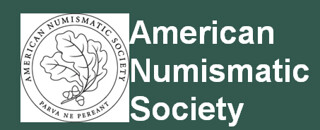 ANS President Ute Wartenberg noted,
ANS President Ute Wartenberg noted, This auction is a lasting, fitting tribute to Mr. Bartlett’s memory. This significant fundraising effort will enable our curators to research other collections and attend conferences around the United States and abroad. The Board of Trustees and the entire staff of the Society are extremely grateful for Mr. Bartlett’s generosity and commitment to our field. Like many of our members, he believed deeply in the Society's mission.
The American Numismatic Society, organized in 1858 and incorporated in 1865 in New York State, operates as a research museum under Section 501(c)(3) of the Internal Revenue Code and is recognized as a publicly supported organization under section 170(b)(1)(A)(vi) as confirmed on November 1, 1970.
To view the auction lots, see:
https://auctions.cngcoins.com/auctions/4-38TINS/keystone-auction-4
WAYNE'S AUGUST 2021 ANA DIARY
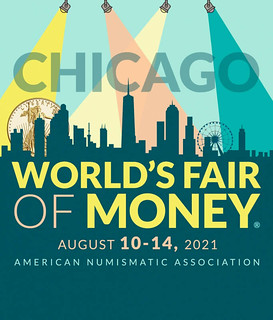 This past week I travelled to the Chicago area for the American Numismatic Association World's Fair of Money. I heard many people had great difficulties travelling by air on Tuesday due
to stormy weather. A typical disruption was experienced by Dave Lange - his flight was delayed a couple hours due to bad weather in Chicago, then bad weather in Florida kept his flight
from leaving for another couple hours. And while the passengers could deplane for a spell, due to the pandemic and labor market there were few shops or restaurants open to serve anyone.
He eventually arrived at O'Hare airport about midnight. Other people had flights rerouted all over the country; at least one person (Bill Hyder) had a 48-hour trip to contend with.
This past week I travelled to the Chicago area for the American Numismatic Association World's Fair of Money. I heard many people had great difficulties travelling by air on Tuesday due
to stormy weather. A typical disruption was experienced by Dave Lange - his flight was delayed a couple hours due to bad weather in Chicago, then bad weather in Florida kept his flight
from leaving for another couple hours. And while the passengers could deplane for a spell, due to the pandemic and labor market there were few shops or restaurants open to serve anyone.
He eventually arrived at O'Hare airport about midnight. Other people had flights rerouted all over the country; at least one person (Bill Hyder) had a 48-hour trip to contend with.
My flight was charmed, however, by Goldilocks timing. My flight took off from Dulles International at 7am Wednesday and arrived two hours later at 8am local time. It was my first trip anywhere since the pandemic began. Masks were mandatory for the flight and all parts of the airport buildings.
One game I play at coin conventions is "Who's First" - who will be the first numismatic friend I see? Often it's a surprise, far from the convention hall. The earliest was the time Eric Newman boarded my plane in a stopover in St. Louis. But on Wednesday I saw (or at least recognized) no one until I got inside the bourse hall where I stopped to talk with Greg Ruby, who was manning the information desk. His mask set the tone for the show.
This photo of the Kuenker table is another sign of the times.
Numismatic Literature Dealers The numismatic literature dealers were set up against the back wall and were among my next stops. I bought this item from Kolbe & Fanning for my ephemera collection - a one-sheet uniface 1909 flyer from Tom Elder hitting back at Farran Zerbe.
Charlie Davis and Dave Schenkman talking at Charlie's table; Neil Musante and David Fanning in the background.
Neil Musante and Eric Schena talking at Charlie's table
David Fanning with a customer at the Kolbe & Fanning table
Julian and ANS I walked the show aisles Wednesday afternoon. While I made a point to visit E-Sylum regulars and supporters, everyone was so busy the best I could do was wave from afar. Here's a shot I took late in the day of Julian Leidman, who was charging his phone at the time.
At the American Numismatic Society table earlier in the day I spoke with Austin Andrews and Jesse Kraft. The hit of their show was their display of William Guild's Plexiglas coin slides
To read the earlier E-Sylum article, see:
THE PLASTIC SLIDES OF WILLIAM GUILD
(https://www.coinbooks.org/v24/esylum_v24n07a20.html)
Zero-Euro Israel Note
We've discussed "Zero Euro" souvenir notes before. This one caught my eye at the table of Elite World Currency.Wednesday Reception and Dinner After leaving the show Wednesday and stopping at my hotel for a bit, I walked over the Gibson's for a reception for the Colonial Coin Collectors Club sponsored by Stack's Bowers. I saw a lot of familiar faces and met some new friends as well. I chatted with Clifford Mishler and Christine Karsteadt for a bit, then had a longer conversation with Brian Kendrella about the new ANA auction arrangements, with lots available at the show for viewing but the sales themselves being held after the show (online and in-person at auction house headquarters). Brian explained that the companies save a lot of money by not having to bring all their auction staff to the show, and I thought it would work out for the buyers as well, making the convention less hectic with one less must-do activity.
Following the reception I went to my hotel's restaurant. Finding the selection lacking, I left and headed to the Mexican restaurant I remembered from a couple years earlier. After ordering, in walked last year's Young Numismatist of the Year, Garrett Ziss with his mom. The three of us got together and had a nice meal. We discussed quite a few topics, from Garrett's summer internship at the Newman Numismatic Portal to his studies at my alma mater, the University of Pittsburgh. I suggested some sights to see on campus, including the Early American Room in the Cathedral of Learning. Championed and funded by well-known numismatist George Clapp, the room includes a podium with a display of early American coinage. And according to this article I saw today, the room is haunted as well.
To read the complete article, see:
Lore & Legends: Hidden Slices of History at Seven Pittsburgh-Area Universities
(https://www.pittsburghmagazine.com/lore-legends-hidden-slices-of-history-at-seven-pittsburgh-area-universities/)
Thursday Events
Thursday was a blur of activity. I first attended the NBS Board Meeting and gave a report on The E-Sylum and future social media plans. In the afternoon I attended the first part of the NBS Symposium with Rusty Goe, but ducked out to get some lunch. Next I attended the ANA Member & Awards Celebration, where I accepted The E-Sylum First Place Award for Outstanding Electronic Numismatic Publication. It was here that my friend Kellen Hoard was named Young Numismatist of the Year for 2021. Congratulations!I had my program signed by everyone at my table, which included Eric Schena, Susan Trask Gingrich, Jeff Shevlin, David Lange, Tom and Jan Snyder, and Phyllis Ross. The event ran over, making me later for Lianna Spurrier's talk on "Solving the Mysteries of the Gaku Ichibu", the rectangular Japanese bar coinage.
After returning to my room again to change clothes, I walked half a mile down to the Carlucci Restaurant for a dinner with the Attinelli Fellowship. It's a group started by George Kolbe and other numismatic literature fanatics. Attendees included Len Augsburger and his wife Deb Kurtz, Charlie Davis, David and Maria Fanning, Tom Harrison, myself, Christopher McDowell, Neil Musante and Dave Perkins. It was a wonderful evening of numismatic fellowship, topped off by the fireworks show we saw while waiting for cars afterwards.
Friday Events
Friday seemed another blur. I worked on The E-Sylum a bit in the morning, then headed to the Hilton, where I'd heard they offered a nice breakfast buffet. It was good. After a short stop at the NBS table to speak with NBS President Tom Harrison, I went upstairs early to set up the room for the General Meeting. See the article elsewhere in this issue for more on the event.
Later in the afternoon I went to the meeting of the International Primitive Money Society to present a talk on Howard Gibbs, a famous Pittsburgh area collector with that specialty.
After another return trip to my hotel to change, I headed back to Gibson's for a dinner organized by Len Augsburger.
Here's a group shot taken by our waiter. From LEFT: Len, Lianna Spurrier, Lianna's mom Sharon, Neil Musante, Heidi Wastweet, Len's wife Deb Kurtz, Charlie Davis, me, Kellen Hoard and Christopher McDowell.
The conversation was delightful and far-ranging. Kellen told us about his visit to Heritage headquarters, Lianna told us about her interest in Japanese gold bar money, Neil discussed the sale of the Baker collection of Washington medals, and everyone had a great time swapping numismatic and non-numismatic stories.
The food was excellent; the drinks and desserts divine. Here are the carrot cake and strawberry shortcake. We started at 6pm and the time flew; we finally broke up around 10pm. What a delightful evening.
WAYNE'S AUGUST 2021 ANA DIARY: EXHIBITS
My first stop at the show was the exhibit area, conveniently located near the front of the hall. Among the first people I encountered was Clifford Mishler, who appeared Zelig-like nearly everywhere I turned at the show. He's got an impressive row of ribbons.
Pete Smith with his jaunty mask, and Tom Harrison
Marc Ricard and Paul Hybert, manning the exhibit table.
Exhibits
While there were fewer categories and exhibits than a normal World's Fair of Money, there was still a lot of nice exhibits to see. I took many photos and here's a sampling.
The coinage of Lebanon
This two-case exhibit held five different Civil War postage scrip notes with actual stamps. Great rarities I never got to add to my own collection. Impressive.
An exhibit of U.S. Patent models for coin-counting devices.
Auction Catalogs of the Albert A. Grinnell Collection of United States Paper Money
Here's the only full-bore numismatic literature exhibit I saw.
Bad Hair on Money
My favorite - Bad Hair on Money
For more exhibit photos, see:
ANA 2021-08 Exhibits
(https://www.flickr.com/photos/coinbooks/albums/72157719682307953)
WAYNE'S AUGUST 2021 ANA DIARY: NBS MEETING
The Friday Numismatic Bibliomania Society meeting was well attended and the bidding was spirited at our annual fundraising auction. Annual membership dues don't cover the full cost of printing and mailing our journal, The Asylum, and these auctions help close the budget gap. About $9,000 was raised this year.
I arrived early to start setting up the room. Jeff Dickerson was already there. He'd come expecting to buy, carrying along an extra piece of luggage for books. He helped me set up chairs along the back wall to display the lots.
Tom Harrison opened the meeting and announced the annual NBS awards (see the article elsewhere in this issue on NBS events at the show).
Everyone present took a turn at introducing themselves and describing their interests. Here's Charles Morgan standing. In the back is NBS Past president Marc Ricard. In the front row are Dan Friedus, Pete Smith, and David Alexander and his wife.
Here's Dan Hamelberg displaying a lot for the bidders. In this shot we can see Bob Evans, Lianna Spurrier and her father, Clifford Mishler, Larry Korchnak, Kellen Hoard and other bidders, with dealer Charlie Davis inspecting upcoming lots in the back.
I came away with two lots for my numismatic ephemera collection: the 1863 Henry Phillips monograph on New Jersey Bills of Credit (Lot 39) and the 1876 Weisman List of United States Coppers (Lot 52).
WAYNE'S AUGUST 2021 ANA DIARY: RITTENHOUSE
My last event of the show was Saturday morning's Rittenhouse Society Breakfast. It was a delight to see a good crowd of old and new members, including founding member Ken Bressett. At my table were Barbara Gregory and her husband Steve Bobbitt, Mark Borchardt and his wife, and Pete Smith.
Ken Bressett speaking about the group and his recently completed book project.
In the foreground are ANA Museum Director Doug Mudd, John Dannreuther, David McCarthy of Kagin's, Neil Shafer, David Fanning, and Christopher McDowell.
Having already checked out of my hotel, I next headed to the Hyatt's airport shuttle. I'd just missed the previous one, so I had to hang out for a bit. A white-haired California gentleman in a T-shirt was talking with the bellman. My half-composed limerick: "It wasn't Walter Breen, Who'd passed from the scene..." Turns out it was Bill Hyder, who introduced himself before I got the chance. Bill's journey to the show took an epic 48 hours of delayed and cancelled flights. Hopefully his trip home was uneventful, as mine was.
What a marvelous show. It was so great to see people again after such a long show hiatus. I'm looking forward now to visiting the upcoming PAN and Whitman Baltimore shows.
NORFOLK HOARD COIN: DEFACED OR JUST DAMAGED?
David Pickup passed along this BBC News story about a defaced (or just damaged?) Roman coin. -Editor
A Roman coin of the last pagan emperor which might have been deliberately damaged as an "act of erasure" was found by two metal detectorists.
It depicts Julian the Apostate, part of Rome's first Christian dynasty, who revived paganism when he became the emperor in AD361.
The coin was part of a hoard found near King's Lynn, Norfolk, in March 2020.
The coin was part of a hoard of at least 15 gold and 226 silver coins which were found in a field near King's Lynn.
It was hidden at the time of Barbarian Conspiracy era, an alleged invasion attempt by Picts and Saxons.
But with just one source claiming it took place and no "archaeological evidence for an invasion, we do wonder whether the turmoil might have been an internal rebellion", Dr Marsden said.
It appears to have been hidden during the AD367 Barbarian Conspiracy, a time of great turmoil in Roman Britain.
A British Museum expert suggested a gouge on the coin around Julian's eyes could be an "act of erasure against the last pagan emperor".
But Adrian Marsden, a numismatist or coin specialist with the Norfolk Historic Environment Service, believes it looks more like accidental damage, as other Julian coins discovered in the hoard remain untouched.
To read the complete article, see:
Pagan Roman emperor coin found in Norfolk field 'deliberately damaged'
(https://www.bbc.com/news/uk-england-norfolk-58001605)
TALMUDIC ERA COIN FOUND IN GALILEE
Arthur Shippee passed along this Jerusalem Post article about a family's discovery of a coin from the Talmudic period between the fourth and fifth centuries. Thanks. -Editor
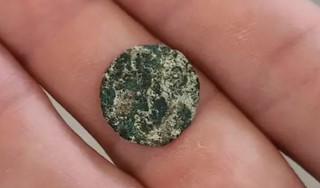 A coin dating back to Talmudic times was found by a family visiting the Korazim National Park in the Galilee, the Nature and Parks Authority announced Tuesday.
A coin dating back to Talmudic times was found by a family visiting the Korazim National Park in the Galilee, the Nature and Parks Authority announced Tuesday.
Korazim features the remains of a Jewish village from the third to sixth century CE), including houses, an olive press, a ritual bath and a decorated synagogue built around the end of the fourth century, when Korazim was in its heyday.
The Yitzhaki family was visiting the site and participating in one of the activities offered to visitors, when one of the daughters found the coin near the ritual bath.
We are talking about an ancient bronze coin that according to a preliminary examination dates back to the Talmudic period between the fourth and fifth centuries CE, about 1,500 years ago,
said Dekel Segev, the director of Korazim.
Segev praised the girl and the family for handing over the coin, which will be transferred to the Israel Antiquities Authority for further research.
The national park offers the visitors several activities, including participation in excavations guided by an archaeologist.
To read the complete article, see:
Talmudic-era coin found in the Galilee by family on a trip
(https://www.jpost.com/archaeology/talmudic-era-coin-found-in-the-galilee-by-family-on-a-trip-676343)
Aaron Oppenheim passed along the story as well. Thanks. -Editor
To read the complete article, see:
Israeli girl finds 1,500-year-old bronze coin near Sea of Galilee
(24news.tv/en/news/israel/society/1628611295-israeli-girl-finds-1-500-year-old-bronze-coin-near-sea-of-galilee)
GLOUCESTERSHIRE MEDIEVAL COIN HOARD
A hoard of 14 hammered coins discovered in Gloucestershire has been declared Treasure. -Editor
A hoard of medieval coins found last winter by a metal detectorist on a Gloucestershire hillside has been declared as treasure.
The oldest coin dates back to King Edward IV with a silver groat minted between 1464 and 1470 which bore the marks that resemble a rose on one side and a crown on the reverse.
The treasure inquest at Gloucester heard last Thursday (Aug 5) that the 14 English silver coins were found on a hillside in Dursley along with half an iron key and fragments of a cast-iron container which were discovered close by.
A Portuguese coin was also found at the same site.
The assistant treasure registrar at British Museum confirmed to the inquest that the finder had permission to metal detect from the landowner when the hoard was found on November 10, 2020.
The expert's report stated that the hoard qualified as treasure because of the age of the coins and their precious metal content.
The Department of Culture Media and Sport said the 14 hammered coins were issued during the reigns of Kings Edward IV, Henry VII and Henry VIII and that the Portuguese coin also dated from the same mediaeval period.
Found via The Explorator newsletter. To subscribe to Explorator, send a blank email message to: explorator+subscribe@groups.io. -Editor
To read the complete article, see:
Medieval silver coins found on Gloucestershire hillside classed as treasure
(https://www.gloucestershirelive.co.uk/news/gloucester-news/medieval-silver-coins-found-gloucestershire-5762923)
1870-CC LIBERTY SEATED HALF REPLICAS STRUCK
The Nevada State Museum in Carson City is using old coin press No 1. to mint replicas of 1870-CC Liberty Seated halves. -Editor
See historic Coin Press No. 1 in action Saturdays in August at the Nevada State Museum, Carson City, before it goes on hiatus in September for maintenance.
The press will be minting reproductions of the 1870 Liberty Seated half dollar from 11 a.m. to 3 p.m. every Saturday in August. The original Liberty Seated coins were minted at the Carson City Mint from 1870 to 1878; the reproductions are minted from Nevada silver and sell for $125.
The Liberty Seated design is a beautiful depiction of the Liberty archetype,
Myron Freedman, director of the Nevada Division of Museums and History, said. Different versions of that design were used on coins in the 19th century, with the 1870 Carson City half-dollar being one of the final versions.
Here's some background on Liberty Seated Design:
The 1870 CC Liberty Seated Half Dollar, sculpted by retired U.S. Mint engraver, Tom Rogers, will be a limited edition and minted with Nevada silver thanks to support from the Coeur Rochester mining company. The story of the CC half dollar, first minted on Coin Press No. 1 in April of 1870, is fascinating.
The original design was created by Christian Gobrecht, third Chief Engraver of the United States Mint. Born in 1785 in Hanover, PA, Gobrecht’s ancestors on his mother’s side went back to the Plymouth Colony in 1642. He apprenticed as a clockmaker and first worked as an engraver for a clockworks company in Baltimore, then later as an engraver of banknotes for a Philadelphia company.
He was also an inventor and invented a tool to reproduce relief on a plain surface, something all engravers would have found useful. There is evidence that Gobrecht did some work for the U.S. Mint as early as 1823 after the death of the first chief engraver Robert Scot, though it was William Kneass who became the second chief engraver, a position Gobrecht sought. Gobrecht was performing work for the Mint when Kneass suffered a debilitating stroke in 1835, and was then made Second
engraver.
He would have created the Liberty Seated design during this period. Kneass died in 1840 and Gobrecht was appointed chief engraver of the U.S. Mint by President Van Buren on December 21, 1840. A position he held until his death in 1844.
The basic Liberty Seated obverse design was used on many coin denominations from 1839 to 1891 (125 dates and varieties) and consisted of the figure of Liberty clad in a flowing dress and seated upon a rock. Gobrecht based his design on sketches from the American painters, Thomas Sully and Titian Peale. Peale’s father was Charles Wilson Peale, who constructed the first museum in the Western Hemisphere, yet another historical connection that enriches the meaning attached to this replica produced by this mint-museum. In her left hand, Liberty holds a pole topped by a Phrygian cap.
This was a popular Neo-classical symbol that depicts a cap given to freed Roman slaves and represents the pursuit of freedom. Her right hand rests on a Union shield inscribed with the word Liberty.
The shield has 13 stripes for the original colonies and represents Freedom’s defense.
To read the complete article, see:
Nevada State Museum coin press in Carson City mints Liberty Seated half dollar replicas this month
(https://carsonnow.org/story/08/05/2021/nevada-state-museum-coin-press-carson-city-mints-liberty-seated-half-dollar-replica)
MOVING MEDALLIC ART COMPANY ARCHIVES, PART 2
Dr. Jesse Kraft of the American Numismatic Society published an ANS Pocket Change blog article, the second segment of a three-part series about the laborious move of the Medallic Art Company archives, purchased by the Society in 2018. Here's an excerpt, but be sure to see the complete article online -Editor
On May 22, with laptop, overly-detailed excel spreadsheet, and solid strategy in mind, I boarded a plane destined for Reno, Nevada. My fine Hyundai Santa Fe rental then took me half-an-hour south to Carson City (just 6.5 miles east of Mound House), to the hotel I would call home for the next 13 nights.
That first evening, I had the pleasure of meeting Rob Vugteveen, self-proclaimed creative problem solver
and former Northwest Territorial Mint employee, and his family. Rob graciously offered his services to the project. Over dinner, we discussed the goals I had set for the following two weeks: (1) to prepare nearly 20,000 die shells for absorption by the ANS upon their arrival in New York City, and (2) to better pack the 5,000 of the more delicate pieces in order to survive the 2,700-mile journey. However, the magnitude of the collection (both in the vastness of the archive itself as well as the diameter of the individual pieces), proved challenging to these lofty goals.
Figure 1. Jesse Kraft (r.) and Rob Vugteveen (l.) in Mound House, NV, beginning to prepare the MACO die shells for their journey across the country.
Pallet-by-pallet, we compared them to the MACO Spreadsheet and used red and green Sharpies to mark the individual item labels with their respective color. From there, we were essentially able to ditch the spreadsheet and work directly from the boxes. We now began on an item-by-item level—opening each box and separating the reds
and the greens
from one another—placing each category into a new box and sealing it when it reached its max weight (ca. 50 pounds), which left most boxes grossly (but necessarily) under-packed.
We had gone through 12 pallets (192 boxes) before suddenly realizing that, at this rate, we would run out of time without even starting on our second task. One achievement from the process, however, was that by the time we were through those 192 boxes, there were only 182 boxes left on the pallets, as we were able to condense those initial boxes by about 5%. Even greater efficiency was found in the fact that we were able to stack the boxes 5-high (as opposed to 4-high, as they previously were) due to information garnered from the shipping companies. This simple change saved an astounding 25% of space.
The next day’s focus was on task number two: repacking what truly needed to be repacked. Due to time constraints in 2018, only about 15,000 of 20,000-odd die shells were photographed, individually wrapped, and safely packed into boxes. At that time, the crew was unable to complete the final 5,000 objects of the collection, so (out of necessity) they were hastily stacked into boxes directly on the pallet. Packed for a quick 6-mile jaunt from Dayton to Mound House, they would not likely survive the 2,500-mile journey they are about to make. Sadly, even now, we found pieces that were clearly broken in their prior transit, not before.
Figure 5. Epoxy die shells for the 1986 ANS medal to commemorate the centennial of the Statue of Liberty.
Most of these objects are epoxy die shells (Figs. 5 & 6). Epoxy die shells were introduced in 1975 as a cheaper and quicker alternative to copper galvano die shells. Unlike the hardy copper die shells made by MACO, the epoxy die shells are quite fragile and if one were dropped on the floor, it could easily shatter on impact. Not only were these most-fragile die shells in direct contact with each other, but each box weighed far beyond their intended capacity.
I am happy to report that Rob Vugteveen and I achieved 95% of what we had hoped to before the time came for me to leave. Thankfully, Rob lives nearby and is able to wrap everything up before the trucks arrive. All in all, the second phase of getting the MACO die shells from Mound House to Manhattan was a success.
To read the complete article, see:
FROM MOUND HOUSE TO MANHATTAN, PART II
(http://numismatics.org/pocketchange/mound-house-ii/)
To read the earlier E-Sylum article, see:
MOVING THE MEDALLIC ART COMPANY ARCHIVES
(https://www.coinbooks.org/v24/esylum_v24n29a32.html)
FEATURED WEB SITE: WAR MEDALS
This week's Featured Web Site is Project Gutenberg's War Medals and Their History, by W. Augustus Steward. It is suggested by Paul Horner, who writes:
"Recently I found this website on War Medals. Extensive worldwide coverage. Many details, with many B&W illustrations. I think many E-Sylum readers would be interested, I am!"
My collection of medals enables me to cover over a hundred years of history; takes me back to the stirring times when men yet met face to face in the Peninsula and at Waterloo; to the men who founded our Indian Empire. It enables me to keep in touch with sailors who fought in the battle of the Nile, at Trafalgar, and at Navarino, that last of all naval battles in which we British took part—our allies were then the French and Russians—until our battleships met those of the Germans in the great war now waging.
It reminds me of the horsemen who made the world wonder ere, with deathless glory, they passed their little day, and of that "thin red line" of Scots, whose cool daring at Balaklava has only been bedimmed by the gallantry of the Light Brigade. It enables me to think more intimately of the men I know who faced the Russians in that terrible winter, and then, like heroes, plodded through the inferno of the Mutiny. It brings back vividly to my mind the days of the Zulu War and the heroism of Rorke's Drift. It reminds me of the daring march to Kandahar and the frontier wars so necessary to hold back the turbulent human surf which beats on the shores of our great Eastern Empire.
It enables me to keep closely in touch with those who so quickly dealt with Arabi Pasha and later faced the fanatical hordes of the Mahdi; the young men of this generation who fought so stubbornly at the Modder River, and who stormed the Tugela Heights. It enables me to keep in touch with those "handymen" and scouts on the fringe of Empire who in Somaliland, Gambia, Benin, Matabeleland, and Bechuanaland uphold the dignity of Britain.

